Adakites, High-Nb Basalts and Copper–Gold Deposits in Magmatic Arcs and Collisional Orogens: An Overview
Abstract
:1. Introduction
2. Adakites
3. High-Nb Basalts
4. Examples of Adakites and High-Nb Basalts Hosting Cu–Au Mineralization
4.1. Russian Far East
4.1.1. Cenozoic Kamchatka Arc
4.1.2. Mesozoic Stanovoy Suture Zone
4.2. Circum-Pacific Magmatic Arcs
4.2.1. Philippines
4.2.2. Indonesia and Papua New Guinea
4.2.3. Andean Magmatic Arc
4.2.4. Southeastern Alaska
4.3. Central Asian Orogenic Belt
4.3.1. Kazakhstan
4.3.2. Trans-Baikal Region
4.3.3. Tuva and Mongolia
4.3.4. Northern China
4.4. The Tethyan Belt
4.4.1. Tibet
4.4.2. Iran and Pakistan
5. Concluding Remarks
Author Contributions
Funding
Institutional Review Board Statement
Informed Consent Statement
Data Availability Statement
Acknowledgments
Conflicts of Interest
References
- Taylor, S.R.; White, A.J.R. Geochemistry of andesites and the growth of continents. Nature 1965, 208, 271–273. [Google Scholar] [CrossRef]
- Rudnick, R.L. Making continental crust. Nature 1995, 378, 571–578. [Google Scholar] [CrossRef]
- Taylor, S.R.; McLennan, S.M. The geochemical evolution of the continental crust. Rev. Geophys. 1995, 33, 241–265. [Google Scholar] [CrossRef]
- Sillitoe, R.H. A plate tectonic model for the origin of porphyry copper deposits. Econ. Geol. 1972, 67, 184–197. [Google Scholar] [CrossRef]
- Mitchell, A.H.; Bell, J.D. Island-arc evolution and related mineral deposits. J. Geol. 1973, 81, 381–405. [Google Scholar] [CrossRef]
- Sawkins, F.J. Metal Deposits in Relation to Plate Tectonics; Springer: Berlin/Heidelberg, Germany, 1984; 325p. [Google Scholar]
- Richards, J. High Sr/Y arc magmas and porphyry Cu ± Mo ± Au deposits: Just add water. Econ. Geol. 2011, 106, 1075–1081. [Google Scholar] [CrossRef]
- Green, T.H.; Ringwood, A.E. Crystallization of basalt and andesite under high pressure hydrous conditions. Earth Planet. Sci. Lett. 1967, 3, 481–489. [Google Scholar] [CrossRef]
- Nicholls, L.A.; Ringwood, A.E. Effect of water on olivine stability in tholeiites and the production of silica saturated magmas in the island-arc environments. J. Geol. 1973, 81, 285–300. [Google Scholar] [CrossRef]
- Miyashiro, A. Volcanic rock series in island arcs and active continental margins. Am. J. Sci. 1974, 274, 321–355. [Google Scholar] [CrossRef]
- Gill, J.B. Orogenic Andesites and Plate Tectonics; Springer: Berlin/Hedielberg, Germany, 1981; 390p. [Google Scholar]
- Foden, J.D. The petrology of the calc-alkaline lavas of Rindjani volcano, East Sunda Arc: A model for island arc petrogenesis. J. Petrol. 1983, 24, 98–130. [Google Scholar] [CrossRef]
- Conrad, W.K.; Kay, R.W. Ultramafic and mafic inclusions from Adak Island: Crystallization history, and implications for the nature of primary magmas and crustal evolution in the Aleutian Arc. J. Petrol. 1984, 25, 88–125. [Google Scholar] [CrossRef]
- Grove, T.L.; Kinzler, R.J. Petrogenesis of andesites. Ann. Rev. Earth Planet. Sci. 1986, 14, 417–454. [Google Scholar] [CrossRef]
- Kushiro, I. Melting of hydrous upper mantle and possible generation of andesitic magma: An approach from synthetic systems. Earth Planet. Sci. Lett. 1974, 22, 294–299. [Google Scholar] [CrossRef]
- Tatsumi, Y.; Eggins, S. Subduction Zone Magmatism; Blackwell: Oxford, UK, 1995; 211p. [Google Scholar]
- Wood, B.J.; Turner, S. Origin of primitive high-Mg andesite: Constraints from natural examples and experiments. Earth Planet. Sci. Lett. 2009, 283, 59–66. [Google Scholar] [CrossRef]
- Eichelberger, J.C. Origin of andesite and dacite: Evidence of mixing at Glass Mountain in California and at other circum-Pacific volcanoes. Geol. Soc. Am. Bull. 1975, 86, 1381–1391. [Google Scholar] [CrossRef]
- Anderson, A. Magma mixing: Petrological process and volcanological tool. J. Volcanol. Geotherm. Res. 1976, 1, 3–33. [Google Scholar] [CrossRef]
- Sakuyama, M. Petrological study of the Myoko and Kurohime volcanoes, Japan: Crystallization sequence and evidence for magma mixing. J. Petrol. 1981, 22, 553–583. [Google Scholar] [CrossRef]
- Gerlach, D.C.; Grove, T.L. Petrology of Medicine Lake Highland volcanics: Characterization of the end members of magma mixing. Contrib. Mineral. Petrol. 1982, 80, 147–159. [Google Scholar] [CrossRef]
- Defant, M.J.; Sherman, S.; Maury, R.C.; Bellon, H.; de Boer, J.; Davidson, J.; Kepezhinskas, P. The geology, petrology, and petrogenesis of Saba Island, Lesser Antilles. J. Volcanol. Geotherm. Res. 2001, 107, 87–111. [Google Scholar] [CrossRef]
- Briqueu, L.; Lancelot, J.R. Rb-Sr systematics and crustal contamination models for calc-alkaline igneous rocks. Earth Planet. Sci. Lett. 1979, 43, 385–396. [Google Scholar] [CrossRef]
- James, D.E. The combined use of oxygen and radiogenic isotopes as indicators of crustal contamination. Annu. Rev. Earth Planet. Sci. Lett. 1981, 9, 311–344. [Google Scholar] [CrossRef]
- Davidson, J.P. Crustal contamination versus subduction zone enrichment: Examples from the Lesser Antilles and implications for mantle source compositions of island arc volcanic rocks. Geochim. Cosmochim. Acta 1987, 51, 2185–2198. [Google Scholar] [CrossRef]
- Hildreth, W.; Moorbath, S. Crustal contributions to arc magmatism in the Andes of Central Chile. Contrib. Mineral. Petrol. 1988, 98, 455–489. [Google Scholar] [CrossRef]
- Beard, J.S.; Lofgren, G.E. Dehydration melting and water-saturated melting of basaltic and andesitic greenstones and amphibolites at 1, 3 and 6.9 kbar. J. Petrol. 1991, 32, 365–401. [Google Scholar] [CrossRef]
- Atherton, M.P.; Petford, N. Generation of sodium-rich magmas from newly underplated basaltic crust. Nature 1993, 362, 144–146. [Google Scholar] [CrossRef]
- Arth, J.G.; Hanson, G.N. Quartz diorites derived by partial melting of eclogite or amphibolite at mantle depths. Contrib. Mineral. Petrol. 1972, 37, 161–174. [Google Scholar] [CrossRef]
- Marsh, B.D. Some Aleutian andesites: Their nature and source. J. Geol. 1976, 84, 27–45. [Google Scholar] [CrossRef]
- Kay, R. Aleutian magnesian andesites: Melts from subducted Pacific ocean crust. J. Volcanol. Geotherm. Res. 1978, 4, 117–132. [Google Scholar] [CrossRef]
- Martin, H. Effect of steeper Archean geothermal gradient on geochemistry of subduction-zone magmas. Geology 1986, 14, 753–756. [Google Scholar] [CrossRef]
- Drummond, M.S.; Defant, M.J. A model for trondhjemite-tonalite-dacite genesis and crustal growth via slab melting: Archaean to modern comparisons. J. Geophys. Res. 1990, 95, 21503–21521. [Google Scholar] [CrossRef]
- Foley, S.F.; Tiepolo, M.; Vannucci, R. Growth of early continental crust controlled by melting of amphibolite in subduction zones. Nature 2002, 417, 837–840. [Google Scholar] [CrossRef]
- Condie, K.C. TTGs and adakites: Are they both slab melts? Lithos 2005, 80, 33–44. [Google Scholar] [CrossRef]
- Martin, H.; Moyen, J.-F.; Guitreau, M.; Blichert-Toft, J.; Le Pennec, J.-L. Why Archean TTG cannot be generated by MORB melting in subduction zone. Lithos 2014, 198–199, 1–13. [Google Scholar] [CrossRef]
- Defant, M.J.; Drummond, M.S. Derivation of some modern arc magmas by melting of young subducted lithosphere. Nature 1990, 347, 662–665. [Google Scholar] [CrossRef]
- Kepezhinskas, P.K. Origin of the hornblende andesites of northern Kamchatka. Int. Geol. Rev. 1989, 31, 246–252. [Google Scholar] [CrossRef]
- Peacock, S.M.; Rushmer, T.; Thompson, A.B. Partial melting of subducting oceanic crust. Earth Planet. Sci. Lett. 1994, 121, 227–244. [Google Scholar] [CrossRef]
- Defant, M.J.; Richerson, P.M.; De Boer, J.Z.; Stewart, R.H.; Maury, R.C.; Bellon, H.; Drummond, M.S.; Feigenson, M.D.; Jackson, T.E. Dacite genesis via both slab melting and differentiation: Petrogenesis of La Yeguada volcanic complex, Panama. J. Petrol. 1991, 32, 1101–1142. [Google Scholar] [CrossRef]
- Defant, M.J.; Clark, L.F.; Stewart, R.H.; Drummond, M.S.; de Boer, J.Z.; Maury, R.C.; Bellon, H.; Jackson, T.E.; Restrepo, J.F. Andesite and dacite genesis via contrasting processes: The geology and geochemistry of El Valle Volcano, Panama. Contrib. Mineral. Petrol. 1991, 106, 309–324. [Google Scholar] [CrossRef]
- Defant, M.J.; Drummond, M.S. Mount St. Helens: Potential example of the partial melting of the subducted lithosphere in a volcanic arc. Geology 1993, 21, 547–550. [Google Scholar] [CrossRef]
- Sajona, F.G.; Maury, R.C.; Bellon, H.; Defant, M.J.; Cotten, J.; Pubellier, M.; Rangin, C. Initiation of subduction and the gen-eration of slab melts in western and eastern Mindanao, Philippines. Geology 1993, 21, 1007–1010. [Google Scholar] [CrossRef]
- Kay, S.M.; Ramos, V.A.; Marquez, M. Evidence in Cerro Pampa volcanic rocks for slab-melting prior to ridge-trench collision in southern South America. J. Geol. 1993, 101, 703–714. [Google Scholar] [CrossRef]
- Hochstaedter, A.G.; Kepezhinskas, P.K.; Defant, M.J.; Drummond, M.S.; Bellon, H. On the tectonic significance of arc volcanism in northern Kamchatka. J. Geol. 1994, 102, 639–654. [Google Scholar] [CrossRef]
- Pe-Piper, G.; Piper, J.W. Miocene magnesian andesites and dacites, Evia, Greece: Adakites associated with subducting slab detachment and extension. Lithos 1994, 31, 125–140. [Google Scholar] [CrossRef]
- Yogodzinski, G.M.; Volynets, O.N.; Koloskov, A.V.; Seliverstov, N.I.; Matveenkov, V.V. Magnesian andesites and the sub-duction component in a strongly calc-alkaline series at Piip Volcano, far western Aleutians. J. Petrol. 1994, 35, 163–204. [Google Scholar] [CrossRef]
- Morris, P.A. Slab melting as an explanation of Quaternary volcanism and aseismicity in south-west Japan. Geology 1995, 23, 395–398. [Google Scholar] [CrossRef]
- Yogodzinski, G.M.; Kay, R.W.; Volynets, O.N.; Koloskov, A.V.; Kay, S.M. Magnesian andesite in the western Aleutian-Komandorsky region: Implications for slab melting and processes in the mantle wedge. Geol. Soc. Am. Bull. 1995, 107, 505–519. [Google Scholar] [CrossRef]
- Drummond, M.S.; Defant, M.J.; Kepezhinskas, P.K. Petrogenesis of slab-derived trondhjemite–tonalite-dacite/adakite magmas. Earth Environ. Sci. Trans. R. Soc. Edinb. 1996, 87, 205–215. [Google Scholar] [CrossRef]
- Stern, C.R.; Kilian, R. Role of the subducted slab, mantle wedge and continental crust in the generation of adakites from the Andean Austral volcanic zone. Contrib. Mineral. Petrol. 1996, 123, 263–281. [Google Scholar] [CrossRef]
- Kepezhinskas, P.; McDermott, F.; Defant, M.J.; Hochstaedter, A.G.; Drummond, M.S.; Hawkesworth, C.J.; Koloskov, A.; Maury, R.C.; Bellon, H. Trace element and Sr-Nd-Pb isotopic constraints on a three-component model of Kamchatka Arc petrogenesis. Geochim. Cosmochim. Acta 1997, 61, 577–600. [Google Scholar] [CrossRef]
- Yogodzinski, G.M.; Kelemen, P.B. Slab melting in the Aleutians: Implications of an ion probe study of clinopyroxene in primitive adakite and basalt. Earth Planet. Sci. Lett. 1998, 158, 53–65. [Google Scholar] [CrossRef]
- Sajona, F.G.; Maury, R.C.; Prouteau, G.; Cotten, J.; Schiano, P.; Bellon, H.; Fontaine, L. Slab melt as metasomatic agent in island arc magma mantle sources, Negros and Batan (Philippines). Isl. Arc 2000, 9, 472–486. [Google Scholar] [CrossRef]
- Aguillon-Robles, A.; Calmus, T.; Benoit, M.; Bellon, H.; Maury, R.C.; Cotten, J.; Bourgois, J.; Michaud, F. Late Miocene adakites and Nb-enriched basalts from Vizcaino Peninsula, Mexico: Indicators of East Pacific Rise subduction below Southern Baja California? Geology 2001, 29, 531–534. [Google Scholar] [CrossRef]
- Defant, M.J.; Jackson, T.E.; Drummond, M.S.; de Boer, J.Z.; Bellon, H.; Feigenson, M.D.; Maury, R.C.; Stewart, R.H. The geochemistry of young volcanism throughout Western Panama and Southern Costa Rica, an overview. J. Geol. Soc. 1992, 149, 569–579. [Google Scholar] [CrossRef]
- Kepezhinskas, P.K.; Defant, M.J.; Drummond, M.S. Na metasomatism in the sub-arc mantle by slab melt-peridotite interaction: Evidence from mantle xenoliths in the Kamchatka arc. J. Petrol. 1995, 36, 1505–1527. [Google Scholar]
- Kepezhinskas, P.K.; Defant, M.J.; Drummond, M.S. Progressive enrichment of island arc mantle by melt-peridotite interaction inferred from Kamchatka xenoliths. Geochim. Cosmochim. Acta 1996, 60, 1217–1229. [Google Scholar] [CrossRef]
- Sajona, F.G.; Maury, R.C.; Bellon, H.; Cotten, J.; Defant, M.J. High field strength element enrichment of Pliocene-Pleistocene island arc basalts, Zamboanga Peninsula, Western Mindanao (Philippines). J. Petrol. 1996, 37, 693–726. [Google Scholar] [CrossRef] [Green Version]
- Defant, M.J.; Kepezhinskas, P. Evidence suggests slab melting in arc magmas. EOS Trans. Am. Geophys. Union 2001, 82, 65–69. [Google Scholar] [CrossRef]
- Wyman, D.; Ayer, J.; Devaney, J.R. Niobium-enriched basalts from the Wabigoon subprovince, Canada: Evidence for adakitic metasomatism above an Archean subduction zone. Earth Planet. Sci. Lett. 2000, 179, 21–30. [Google Scholar] [CrossRef]
- Polat, A.; Kerrich, R. Magnesian andesites, Nb-enriched basalt-andesites, and adakites from late-Archean 2.7 Ga Wawa greenstone belts, Superior Province, Canada: Implications for late Archean subduction zone petrogenetic processes. Contrib. Mineral. Petrol. 2001, 141, 36–52. [Google Scholar] [CrossRef]
- Hollings, P. Archean Nb-enriched basalts in the northern Superior Province. Lithos 2002, 64, 1–14. [Google Scholar] [CrossRef]
- Zhang, H.; Niu, H.; Sato, H.; Yu, X.; Shan, Q.; Zhang, B.; Ito, J.; Nagao, T. Late Paleozoic adakites and Nb-enriched basalts from northern Xinjiang, northwest China: Evidence for the southward subduction of the Paleo-Asian oceanic plate. Isl. Arc 2005, 14, 55–68. [Google Scholar] [CrossRef]
- Wang, Q.; Wyman, D.; Xu, J.; Wan, Y.; Li, C.; Zi, F.; Jiang, Z.; Qiu, H.; Chu, Z.; Zhao, Z.; et al. Triassic Nb-enriched basalts, magnesian andesites, and adakites of the Qiangtang terrane (Central Tibet): Evidence for metasomatism by slab-derived melts in the mantle wedge. Contrib. Mineral. Petrol. 2008, 155, 473–490. [Google Scholar] [CrossRef]
- Xu, J.-F.; Shinjo, R.; Defant, M.J.; Wang, Q.; Rapp, R.P. Origin of Mesozoic adakitic intrusive rocks in the Ningzhen area of east China: Partial melting of delaminated lower continental crust? Geology 2002, 30, 1111–1114. [Google Scholar] [CrossRef]
- Kay, R.W.; Kay, S.M. Andean adakites: Three ways to make them. Acta Petrol. Sin. 2002, 18, 303–311. [Google Scholar]
- Chung, S.-L.; Liu, D.; Ji, J.; Chu, M.-F.; Lee, H.-Y.; Wen, D.-J.; Lo, C.-H.; Lee, T.-Y.; Qian, Q.; Zhang, Q. Adakites from continental collision zones: Melting of thickened lower crust beneath southern Tibet. Geology 2003, 31, 1021–1024. [Google Scholar] [CrossRef] [Green Version]
- Wang, Q.; McDermott, F.; Xu, J.-F.; Bellon, H.; Zhu, Y.-T. Cenozoic K-rich adakitic volcanic rocks in the Hohxil area, northern Tibet: Lower-crustal melting in an intracontinental setting. Geology 2005, 33, 465–468. [Google Scholar] [CrossRef] [Green Version]
- Qian, Q.; Hermann, J. Partial melting of lower crust at 10–15 kbar: Constraints on adakite and TTG formation. Contrib. Mineral. Petrol. 2013, 165, 1195–1224. [Google Scholar] [CrossRef]
- Long, X.; Wilde, S.A.; Wang, Q.; Yuan, C.; Wang, X.-C.; Li, J.; Jiang, Z.; Dan, W. Partial melting of thickened continental crust in central Tibet: Evidence from geochemistry and geochronology of Eocene adakitic rhyolites in the northern Qiangtang Terrane. Earth Planet. Sci. Lett. 2015, 414, 30–40. [Google Scholar] [CrossRef]
- Guo, Z.F.; Wilson, M.; Liu, J.Q. Post-collisional adakites in south Tibet: Products of partial melting of subduction-modified lower crust. Lithos 2007, 96, 205–224. [Google Scholar] [CrossRef]
- Jiang, N.; Liu, Y.S.; Zhou, W.G.; Yang, J.H.; Zhang, S.Q. Derivation of Mesozoic adakitic magmas from ancient lower crust in the Northern China craton. Geochim. Cosmochim. Acta 2007, 71, 2591–2608. [Google Scholar] [CrossRef]
- Castillo, P.R.; Janney, P.E.; Solidum, R.U. Petrology and geochemistry of Camiguin Island, southern Philippines: Insights to the source of adakites and other lavas in a complex arc setting. Contrib. Mineral. Petrol. 1999, 134, 33–51. [Google Scholar] [CrossRef]
- Macpherson, C.G.; Dreher, S.T.; Thirlwall, M. Adakites without slab melting: High-pressure differentiation of island arc magma, Mindanao, the Philippines. Earth Planet. Sci. Lett. 2006, 281, 581–593. [Google Scholar] [CrossRef] [Green Version]
- Rodriguez, C.; Selles, D.; Dungan, M.; Langmuir, C.; Leeman, W. Adakitic dacites formed by intracrustal crystal fractionation of water-rich parent magmas at Nevado de Longavi Volcano (36.2 °S, Andean Southern Volcanic Zone, Central Chile). J. Petrol. 2007, 48, 2033–2061. [Google Scholar] [CrossRef] [Green Version]
- Chiaradia, M.; Müntener, O.; Beate, B.; Fontignie, D. Adakite-like volcanism of Ecuador: Lower crust magmatic evolution and recycling. Contrib. Mineral. Petrol. 2009, 158, 563–588. [Google Scholar] [CrossRef] [Green Version]
- Ribeiro, J.M.; Maury, R.C.; Gregoire, M. Are adakites slab melts or high-pressure fractionated mantle melts? J. Petrol. 2016, 57, 839–862. [Google Scholar]
- Calmus, T.; Aguillon-Robles, A.; Maury, R.C.; Bellon, H.; Benoit, M.; Cotton, J.; Bourgois, J.; Michaud, F. Spatial and temporal evolution of basalts and magnesian andesites (“bajaites”) from Baja California, Mexico: The role of slab melts. Lithos 2003, 66, 77–105. [Google Scholar] [CrossRef]
- Martin, H.; Smithies, R.H.; Rapp, R.; Moyen, J.-F.; Champion, D. An overview of adakite, tonalite-trondhjemite-granodiorite (TTG), and sanukitoid: Relationships and some implications for crustal evolution. Lithos 2005, 79, 1–24. [Google Scholar] [CrossRef]
- Castillo, P.R. An overview of adakite perogenesis. Chin. Sci. Bull. 2006, 51, 257–268. [Google Scholar] [CrossRef]
- Thieblemont, D.; Stein, G.; Lescuyer, G.L. Epithermal and porphyry deposits: The adakite connection. C. R. Acad. Sci. Ser. IIA Earth. Planet. Sci. 1997, 325, 103–109. [Google Scholar]
- Sajona, F.G.; Maury, R. Association of adakites with gold and copper mineralization in the Philippines. C. R. Acad. Sci. Ser. IIA Earth. Planet. Sci. 1998, 326, 27–34. [Google Scholar] [CrossRef]
- Oyarzun, R.; Marquez, A.; Lillo, J.; Lopez, I.; Rivera, S. Giant versus small porphyry copper deposits of Cenozoic age in northern Chile: Adakitic versus normal calc-alkaline magmatism. Miner. Depos. 2001, 36, 794–798. [Google Scholar] [CrossRef]
- Reich, M.; Parada, M.A.; Palacios, C.; Dietrich, A.; Schultz, F.; Lehmann, B. Adakite-like signature of Late Miocene intrusions at the Los Pelambres giant porphyry copper deposit in the Andes of Coastal Chile: Metallogenic implications. Miner. Depos. 2003, 38, 876–885. [Google Scholar] [CrossRef] [Green Version]
- Sun, W.D.; Zhang, H.; Ling, M.-X.; Ding, X.; Chung, S.-L.; Zhou, J.B.; Yang, X.-Y.; Fan, W.M. The genetic association of adakites and Cu–Au ore deposits. Int. Geol. Rev. 2011, 53, 691–703. [Google Scholar] [CrossRef]
- Mungall, J.E. Roasting the mantle: Slab melting and the genesis of major Au and Au-rich Cu deposits. Geology 2002, 30, 915–918. [Google Scholar] [CrossRef]
- Richards, J.P.; Kerrich, R. Special paper: Adakite-like rocks: Their diverse origins and questionable role in metallogenesis. Econ. Geol. 2007, 102, 537–576. [Google Scholar] [CrossRef]
- Chiaradia, M.; Ulianov, A.; Kouzmanov, K.; Beate, B. Why large porphyry Cu deposits like high Sr/Y magmas? Sci. Rep. 2012, 2, 685. [Google Scholar] [CrossRef] [Green Version]
- Wang, Q.; Xu, J.-F.; Jian, P.; Bao, Z.-W.; Zhao, Z.-H.; Li, C.-F.; Xiong, X.C.; Ma, J.L. Petrogenesis of adakitic porphyries in an extensional tectonic setting, Dexing, South China: Implications for the genesis of porphyry copper mineralization. J. Petrol. 2006, 47, 119–144. [Google Scholar] [CrossRef]
- Defant, M.J.; Xu, J.F.; Kepezhinskas, P.K.; Wang, Q.; Qi, Z.; Xiao, L. Adakites: Some variations on a theme. Acta Petrol. Sin. 2002, 18, 129–142. [Google Scholar]
- Moyen, J.-F. High Sr/Y and La/Yb ratios: The meaning of the “adakitic” signature. Lithos 2009, 112, 556–574. [Google Scholar] [CrossRef]
- Bindeman, I.N.; Eiler, J.M.; Yogodzinski, G.M.; Tatsumi, Y.; Stern, C.R.; Grove, T.L.; Portnyagin, M.; Hoernle, K.; Danyushevsky, L.V. Oxygen isotope evidence for slab melting in modern and ancient subduction zones. Earth Planet. Sci. Lett. 2005, 235, 480–496. [Google Scholar] [CrossRef]
- Tomascak, P.B.; Ryan, J.G.; Defant, M.J. Lithium isotope evidence for light element decoupling in the Panama subarc mantle. Geology 2002, 28, 507–510. [Google Scholar] [CrossRef] [Green Version]
- Widom, E.; Kepezhinskas, P.; Defant, M.J. The nature of metasomatism in the sub-arc mantle wedge: Evidence from Re-Os isotopes in Kamchatka peridotite xenoliths. Chem. Geol. 2003, 196, 283–306. [Google Scholar] [CrossRef]
- Dreher, S.T.; MacPherson, C.G.; Pearson, D.G.; Davidson, J.P. Re-Os isotope studies of Mindanao adakites: Implications for sources of metals and melts. Geology 2005, 33, 957–960. [Google Scholar] [CrossRef]
- Bezard, R.; Turner, S.; Schaefer, B.; Togodzinski, G.; Hoernle, K. Os isotope composition of western Aleutian adakites: Implications for the Re/Os of oceanic crust processed through hot subduction zones. Geochim. Cosmochim. Acta 2021, 292, 452–467. [Google Scholar] [CrossRef]
- Sigmarsson, O.; Martin, H.; Knowles, J. Melting of a subducting oceanic crust from U–Th disequilibria in austral Andean lavas. Nature 1998, 394, 566–569. [Google Scholar] [CrossRef]
- Tokunaga, S.; Nakai, S.; Orihashi, Y. Two types of adakites revealed by 238U-230Th disequilibrium from Daisen Volcano, southwestern Japan. Geochem. J. 2010, 44, 379–386. [Google Scholar] [CrossRef] [Green Version]
- Coldwell, B.; Adam, J.; Rushmer, T.; Macpherson, C.G. Evolution of the East Philippine Arc: Experimental constraints on magmatic phase relations and adakitic melt formation. Contrib. Mineral. Petrol. 2011, 162, 835. [Google Scholar] [CrossRef] [Green Version]
- Du, J.-G.; Du, Y.-S.; Cao, Y. Important role of hornblende fractionation in generating the adakitic magmas in Tongling, Eastern China: Evidence from amphibole megacryst and cumulate xenoliths and host gabbros. Int. Geol. Rev. 2018, 60, 1381–1403. [Google Scholar] [CrossRef]
- Foley, F.V.; Pearson, N.J.; Rushmer, T.; Turner, S.; Adam, J. Magmatic evolution and magma mixing of Quaternary adakites at Solander and little Solander Islands, New Zealand. J. Petrol. 2013, 54, 703–744. [Google Scholar] [CrossRef] [Green Version]
- Jego, S.; Maury, R.C.; Polvé, M.; Yumul, G.P., Jr.; Bellon, H.; Tamayo, R.A., Jr.; Cotten, J. Geochemistry of Adakites from the Philippines: Constraints on their origins. Resour. Geol. 2005, 55, 163–187. [Google Scholar] [CrossRef]
- McDonough, W.F.; Sun, S.-s. The composition of the Earth. Chem. Geol. 1995, 120, 223–253. [Google Scholar] [CrossRef]
- Beate, B.; Monzier, M.; Spikings, R.; Cotten, J.; Silva, J.; Bourdon, E.; Eissen, J.-P. Mio–Pliocene adakite generation related to flat subduction in southern Ecuador: The Quimsacocha volcanic center. Earth Planet. Sci. Lett. 2001, 192, 561–570. [Google Scholar] [CrossRef]
- Wang, X.-C.; Liu, Y.-S.; Liu, X.-M. Mesozoic adakites in the Lingqui Basin of the central North China Craton: Partial melting of underplated basaltic lower crust. Geochem. J. 2006, 40, 447–461. [Google Scholar] [CrossRef] [Green Version]
- Zhao, Z.H.; Xiong, X.L.; Wang, Q.; Wyman, D.A.; Bao, Z.W.; Bai, Z.H.; Qiao, Y.L. Underplating-related adakites in Xinjiang Tianshan, China. Lithos 2008, 102, 374–391. [Google Scholar] [CrossRef]
- Huang, F.; Li, S.; Dong, F.; He, Y.; Chen, F. High-Mg adakitic rocks in the Dabie orogen, central China: Implications for foundering mechanism of lower continental crust. Chem. Geol. 2008, 255, 1–13. [Google Scholar] [CrossRef]
- He, Y.; Li, S.; Hoefs, J.; Huang, F.; Liu, S.-A.; Hou, Z. Post-collisional granitoids from the Dabie orogeny: New evidence for partial melting of a thickened continental crust. Geochim. Cosmochim. Acta 2011, 75, 3815–3838. [Google Scholar] [CrossRef]
- Li, J.-X.; Qin, K.-Z.; Li, G.-M.; Xiao, B.; Chen, L.; Zhao, J.-X. Post-collisional ore-bearing adakitic porphyries from Gangdese porphyry copper belt, southern Tibet: Melting of thickened juvenile arc lower crust. Lithos 2011, 126, 265–277. [Google Scholar] [CrossRef]
- Chen, Y.-X.; Xia, X.-H.; Song, S.-G. Petrogenesis of Aoyougou high-silica adakite in the North Qilian orogeny, NW China: Evidence for decompression melting of oceanic slab. Chin. Sci. Bull. 2012, 57, 2289–2301. [Google Scholar] [CrossRef] [Green Version]
- Zhang, Z.; Li, G.M.; Cao, H.W.; Zhang, L.K.; Huang, Y.; Dong, S.-J.; Lu, L.; Liu, Y.Q. Miocene potassic and adakitic intrusions in eastern central Lhasa terrane, Tibet: Implications for the origin and tectonic of postcollisional magmatism. Geol. J. 2020, 55, 3036–3053. [Google Scholar] [CrossRef]
- Eyuboglu, Y.; Santosh, M.; Dudas, F.O.; Akaryali, E.; Chung, S.-L.; Akdag, K.; Bektas, O. The nature of ttransition from adakitic to non-adakitic magmatism in a slab window setting: A synthesis from the eastern Pontides, NE Turkey. Geosci. Front. 2013, 4, 353–375. [Google Scholar] [CrossRef] [Green Version]
- Xu, W.-C.; Zhang, H.-F.; Luo, B.-J.; Guo, L.; Yang, H. Adakite-like geochemical signature produced by amphibole-dominated fractionation of arc magmas: An example from the Late Cretaceous magmatism in Gangdese belt, south Tibet. Lithos 2015, 232, 197–210. [Google Scholar] [CrossRef]
- Azizi, H.; Stern, R.J.; Topuz, G.; Asahara, Y.; Moghadan, H.S. Late Paleocene adakites from NW Iran and comparison with adakites in the NE Turkey: Adakite melt generation in normal continental crust. Lithos 2019, 346–347, 105151. [Google Scholar] [CrossRef]
- Li, Y.; Wang, J.; Xin, H.; Dong, P.; Li, H. Subduction initiation in the southeastern Palaeo-Asian Ocean: Constraints from early Permian adakites in suprasubduction zone ophiolites, central Inner Mongolia, North China. Geol. J. 2019, 55, 2044–2061. [Google Scholar] [CrossRef]
- Kimura, J.-I.; Stern, R.J.; Yoshida, T. Reinitiation of subduction and magmatic responses in SW Japan during Neogene time. Geol. Soc. Am. Bull. 2005, 117, 969–986. [Google Scholar] [CrossRef] [Green Version]
- Gutscher, M.-A.; Maury, R.C.; Eissen, J.-P.; Bourdon, E. Can slab melting be caused by flat subduction? Geology 2000, 28, 535–538. [Google Scholar] [CrossRef] [Green Version]
- Ji, Z.; Meng, Q.A.; Wan, C.B.; Zhu, D.F.; Ge, W.C.; Zhang, Y.L.; Yang, H.; Dong, Y. Geodynamic evolution of flat-slab subduction of Paleo-Pacific Plate: Constraints from Jurassic adakitic lavas in the Hailar Basin, NE China. Tectonics 2019, 38, 4301–4319. [Google Scholar] [CrossRef]
- Goss, A.R.; Kay, S.M.; Mpodozis, C. Andean adakite-like high-Mg andesites on the northern margin of the Chilean-Pampean flat-slab (27-28.50S) associated with frontal arc migration and fore-arc subduction erosion. J. Petrol. 2013, 54, 2193–2234. [Google Scholar] [CrossRef] [Green Version]
- Rooney, T.O.; Morrell, K.D.; Hidalgo, P.; Fraceschi, P. Magmatic consequences of the transition from orthogonal to oblique subduction in Panama. Geochim. Geophys. Geosyst. 2015, 16, 4178–4208. [Google Scholar] [CrossRef] [Green Version]
- Berkelhammer, S.E.; Brueseke, M.E.; Benowitz, J.A.; Trop, J.M.; Davis, K.; Layer, P.W.; Weber, M. Geochemical and geochronological records of tectonic changes along a flat-slab arc-transform junction: Circa 30 Ma to ca. 19 Ma Sonya Creek volcanic field, Wrangell Arc, Alaska. Geosphere 2019, 15, 1508–1538. [Google Scholar] [CrossRef]
- Nakamura, H.; Iwamori, H. Generation of adakites in a cold subduction zone due to double subducting plates. Contrib. Mineral. Petrol. 2013, 165, 1107–1134. [Google Scholar] [CrossRef]
- Yogodzinski, G.M.; Lees, J.M.; Churikova, T.G.; Dorendorf, F.; Wöerner, G.; Volynets, O.N. Geochemical evidence for the melting of subducting oceanic lithosphere at plate edges. Nature 2001, 409, 500–504. [Google Scholar] [CrossRef] [PubMed]
- Zhang, L.-Y.; Ducea, M.N.; Ding, L.; Pullen, A.; Kapp, P.; Hoffman, D. Southern Tibetan Oligocene–Miocene adakites: A record of Indian slab tearing. Lithos 2014, 210–211, 209–223. [Google Scholar] [CrossRef]
- Thorkelson, D.J.; Breitsprecher, K. Partial melting of slab window margins: Genesis of adakitic and non-adakitic magmas. Lithos 2005, 79, 25–41. [Google Scholar] [CrossRef]
- Castillo, P.R. Origin of the adakite-high-Nb basalt association and its implications for postsubduction magmatism in Baja California, Mexico. Geol. Soc. Am. Bull. 2008, 120, 451–462. [Google Scholar] [CrossRef]
- Reagan, M.K.; Gill, J.B. Coexisting calcalkaline and high-niobium basalts from Turrialba Volcano, Costa Rica: Implications for residual titanates in arc magma sources. J. Geophys. Res. 1989, 94, 4619–4633. [Google Scholar] [CrossRef]
- Hastie, A.R.; Mitchell, S.F.; Kerr, A.C.; Minifie, M.J.; Millar, I.L. Geochemistry of rare high-Nb basalt lavas: Are they derived from a mantle wedge metasomatized by slab melts? Geochim. Cosmochim. Acta 2011, 75, 5049–5072. [Google Scholar] [CrossRef] [Green Version]
- Macpherson, C.G.; Chiang, K.K.; Hall, R.; Nowell, G.M.; Castillo, P.; Thirlwall, M.F. Plio-Pleistocene intra-plate magmatism from the southern Sulu Arc, Semporna peninsula, Sabah, Borneo: Implications for high-Nb basalt in subduction zones. J. Volcanol. Geotherm. Res. 2010, 190, 25–38. [Google Scholar] [CrossRef] [Green Version]
- Kepezhinskas, N.; Kamenov, G.D.; Foster, D.A.; Kepezhinskas, P. Petrology and geochemistry of alkaline basalts and gabbroic xenoliths from Utila Island (Bay Islands, Honduras): Insights into back-arc processes in the Central American Volcanic Arc. Lithos 2020, 352–353, 105306. [Google Scholar] [CrossRef]
- Oshika, J.; Arakawa, Y.; Endo, D.; Shinmara, T.; Mori, Y. A rare basanite distribution in the northern part of the Izu-Bonin volcanic arc, Japan: Petrological and geochemical constraints. J. Volcanol. Geotherm. Res. 2014, 270, 76–89. [Google Scholar] [CrossRef]
- Hastie, A.R.; Kerr, A.C.; Mitchell, S.F.; Pearce, J.A.; McDonald, I.; Millar, I.; Barfod, D.; Mark, D.F. Geochemistry and petro-genesis of rhyodacite lavas in eastern Jamaica: A new adakite subgroup analogous to early Archaean continental crust? Chem. Geol. 2010, 276, 344–359. [Google Scholar] [CrossRef]
- Le Maitre, R.W.; Bateman, P.; Dudek, A.; Keller, J.; Lameyre, J.; Le Bas, M.J.; Sabine, P.A.; Schmid, R.; Sorensen, H.; Streckeisen, A.; et al. A Classification of Igneous Rocks and Glossary of Terms: Recommendations of the International Union of Geological Sciences Subcomission on the Systematics of Igneous Rocks; Blackwell: Oxford, UK, 1989; p. 193. [Google Scholar]
- Janoušek, V.; Erban, V.; Holub, F.V.; Magna, T.; Bellon, H.; Mlčoch, B.; Wiechert, U.; Rapprich, V. Geochemistry and genesis of behind-arc basaltic lavas from eastern Nicaragua. J. Volcanol. Geotherm. Res. 2010, 192, 232–256. [Google Scholar] [CrossRef]
- Heydolph, K.; Hoernle, K.; Hauff, F.; van der Bogaard, P.; Portnyagin, M.; Bindeman, I.; Garbe-Schönberg, D. Along and across arc geochemical variations in NW Central America: Evidence for involvement of lithospheric pyroxenite. Geochim. Cosmochim. Acta 2012, 84, 459–491. [Google Scholar] [CrossRef]
- Azizi, H.; Asahara, Y.; Tsuboi, M. Quaternary high-Nb basalts: Existence of young oceanic crust under the Sanandaj-Sirjan Zone, NW Iran. Int. Geol. Rev. 2014, 56, 167–186. [Google Scholar] [CrossRef]
- Kuritani, T.; Sakuyama, T.; Kamada, N.; Yokoyama, T.; Nakagawa, M. Fluid-fluxed melting of mantle versus decompression melting of hydrous mantle plume as the cause of intraplate magmatism over a stagnant slab: Implications from Fukue Volcano Group, SW Japan. Lithos 2017, 282–283, 98–110. [Google Scholar] [CrossRef]
- Macdonald, G.A.; Katsura, T. Chemical composition of Hawaiian lavas. J. Petrol. 1964, 5, 82–133. [Google Scholar] [CrossRef]
- Irvine, T.N.; Baragar, W.R.A. A Guide to the chemical classification of the common volcanic rocks. Can. J. Earth Sci. 1971, 8, 523–548. [Google Scholar] [CrossRef]
- Kamenetsky, V.S.; Everard, J.L.; Crawford, A.J.; Varne, R.; Eggins, S.M.; Lanyon, R. Enriched end-member of primitive MORB melts: Petrology and geochemistry of glasses from Macquarie Island (SW Pacific). J. Petrol. 2000, 41, 411–430. [Google Scholar] [CrossRef] [Green Version]
- Sun, S.-S.; McDonough, W.F. Chemical and isotopic systematics of oceanic basalts: Implications for mantle composition and processes. Geol. Soc. Lond. Spec. Publ. 1989, 42, 313–345. [Google Scholar] [CrossRef]
- Bailey, J.C.; Frolova, T.I.; Burikova, I.A. Mineralogy, geochemistry and petrogenesis of Kurile island-arc basalts. Contrib. Mineral. Petrol. 1989, 102, 265–280. [Google Scholar] [CrossRef]
- Peate, D.W.; Pearce, J.A.; Hawkesworth, C.J.; Colley, H.; Edwards, C.M.H.; Hirose, K. Geochemical variations in Vanuatu Arc lavas: The role of subducted material and a variable mantle wedge composition. J. Petrol. 1997, 38, 1331–1358. [Google Scholar] [CrossRef]
- Kimura, J.-I.; Yoshida, T. Contributions of slab fluid, mantle wedge and crust to the origin of Quaternary lavas in the NE Japan Arc. J. Petrol. 2006, 47, 2185–2232. [Google Scholar] [CrossRef] [Green Version]
- Schuth, S.; Münker, C.; König, S.; Qopoto, C.; Basi, S.; Garbe-Schönberg, D.; Ballhaus, C. Petrogenesis of lavas along the Solomon Island Arc, SW Pacific: Coupling of compositional variations and subduction zone geometry. J. Petrol. 2009, 50, 781–811. [Google Scholar] [CrossRef]
- Martynov, Y.A.; Khanchuk, A.I.; Kimura, J.L.; Rybin, A.V.; Martynov, A.Y. Geochemistry and petrogenesis of volcanic rocks in the Kuril island arc. Petrology 2010, 18, 489–513. [Google Scholar] [CrossRef]
- Sorbadere, F.; Schiano, P.; Métrich, N.; Bertagnini, A. Small-scale coexistence of island-arc- and enriched-MORB-type basalts in the central Vanuatu arc. Contrib. Mineral. Petrol. 2013, 166, 1305–1321. [Google Scholar] [CrossRef]
- Mullen, E.K.; McCallum, I.S. Origin of basalts in a hot subduction setting: Petrological and geochemical insights from Mt. Baker, Northern Cascade Arc. J. Petrol. 2014, 55, 241–281. [Google Scholar] [CrossRef] [Green Version]
- Churikova, T.G.; Gordeychik, B.N.; Iwamori, H.; Nakamura, H.; Ishizuka, O.; Nishizawa, T.; Haraguchi, S.; Miyazaki, T.; Vaglarov, B.S. Petrological and geochemical evolution of the Tolbachik volcanic massif, Kamchatka, Russia. J. Volcanol. Geotherm. Res. 2015, 307, 156–181. [Google Scholar] [CrossRef] [Green Version]
- White, W.M.; Hofmann, A.W. Sr and Nd isotope geochemistry of oceanic basalts and mantle evolution. Nature 1982, 296, 821–825. [Google Scholar] [CrossRef]
- Petrone, C.M.; Ferrari, L. Quaternary adakite—Nb-enriched basalt association in the western Trans-Mexican Volcanic Belt: Is there any slab melt evidence? Contrib. Mineral. Petrol. 2008, 156, 73–86. [Google Scholar] [CrossRef]
- Kepezhinskas, P.; Kepezhinskas, N. Diverse origins of high-Nb basalts in volcanic arcs. In Proceedings of the 8th IAVCEI International Maar Conference, Petropavlovsk-Kamchatskiy, Russia, 24–30 August 2020; pp. 62–63. [Google Scholar]
- Gale, A.; Dalton, C.A.; Langmuir, C.H.; Su, Y.; Schilling, J.-G. The mean composition of ocean ridge basalts. Geochem. Geophys. Geosyst. 2013, 14, 489–518. [Google Scholar] [CrossRef] [Green Version]
- Castillo, P.R.; Rigby, S.J.; Solidum, R.U. Origin of high field strength element enrichment in volcanic arcs: Geochemical evidence from the Sulu Arc, southern Philippines. Lithos 2007, 97, 271–288. [Google Scholar] [CrossRef]
- Gill, J.B. Sr-Pb-Nd isotopic evidence that both MORB and OIB sources contribute to oceanic island arc magmas in Fiji. Earth Planet. Sci. Lett. 1984, 68, 443–458. [Google Scholar] [CrossRef]
- König, S.; Schuth, S. Deep melting of old subducted oceanic crust recorded by superchondritic Nb/Ta in modern island arc lavas. Earth Planet. Sci. Lett. 2010, 301, 265–274. [Google Scholar] [CrossRef]
- Zhang, G.; Niu, Y.; Song, S.; Zhang, L.; Tian, Z.; Christy, A.G.; Han, L. Trace element behavior and P-T-t evolution during partial melting of exhumed eclogite in the North Qaidam UHPM belt (NW China): Implications for adakite genesis. Lithos 2015, 226, 65–80. [Google Scholar] [CrossRef]
- Xiong, X.; Keppler, H.; Audetat, A.; Ni, H.; Sun, W.; Li, Y. Partitioning of Nb and Ta between rutile and felsic melt and the fractionation of Nb/Ta during partial melting of hydrous metabasalt. Geochim. Cosmochim. Acta 2011, 75, 1673–1692. [Google Scholar] [CrossRef]
- Storkey, A.C.; Hermann, J.; Hand, M.; Buick, I.S. Using In Situ trace-element determinations to monitor partial-melting processes in metabaslites. J. Petrol. 2005, 46, 1283–1308. [Google Scholar] [CrossRef] [Green Version]
- Chen, W.; Xiong, X.; Wang, J.; Xue, S.; Li, L.; Liu, X.; Ding, X.; Song, M. TiO2 solubility and Nb and Ta partitioning in rutile-silica-rich supercritical fluid systems: Implications for subduction zone processes. J. Geophys. Res. Solid Earth 2018, 123, 4765–4782. [Google Scholar] [CrossRef]
- Zhang, L.; Hu, Y.; Liang, J.; Ireland, T.; Chen, Y.; Zhang, R.; Sun, S.; Sun, W. Adakitic rocks associated with the Shilu copper-molybdenum deposit in the Yangchun Basin, South China, and their tectonic implications. Acta Geochim. 2017, 36, 132–150. [Google Scholar] [CrossRef] [Green Version]
- Prouteau, G.; Scaillet, B.; Pichavant, M.; Maury, R. Evidence for mantle metasomatism by hydrous silicic melts derived from subducted oceanic crust. Nature 2001, 410, 197–200. [Google Scholar] [CrossRef] [PubMed] [Green Version]
- Coltorti, M.; Bonadiman, C.; Faccini, B.; Gregoire, M.; O’Reilly, S.Y.; Powell, W. Amphiboles from suprasubduction and in-traplate lithospheric mantle. Lithos 2007, 99, 68–84. [Google Scholar] [CrossRef]
- Kilian, R.; Stern, C.R. Constraints on the interaction between slab melts and the mantle wedge from adakitic glass in peridotite xenoliths. Eur. J. Mineral. 2002, 14, 25–36. [Google Scholar] [CrossRef]
- Faccini, B.; Bonadiman, C.; Coltorti, M.; Gregoire, M.; Siena, F. Oceanic material recycled within the sub-patagonian litho-spheric mantle (Cerro del Fraile, Argentina). J. Petrol. 2013, 54, 1211–1258. [Google Scholar] [CrossRef] [Green Version]
- Shimizu, Y.; Arai, S.; Morishita, T.; Yurimoto, H.; Gervilla, F. Petrochemical characteristics of felsic veins in mantle xenoliths from Tallante (SE Spain): An insight into activity of silicic melt within the mantle wedge. Earth Environ. Sci. Trans. R. Soc. Edinb. 2004, 95, 265–276. [Google Scholar] [CrossRef]
- Kepezhinskas, P.K.; Reuber, I.; Tanaka, H.; Miyashita, S. Zoned calc-alkaline plutons in northeastern Kamchatka, Russia: Implications for the crustal growth in magmatic arcs. Mineral. Petrol. 1993, 49, 147–174. [Google Scholar] [CrossRef]
- Bogdanov, N.A.; Kepezhinskas, P.K. Lithospheric heterogeneity in the continental framing of the Komandorsky Basin, Bering Sea. In Tectonics of Circum Pacific Continental Margins; Aubouin, J., Bourgeois, J., Eds.; VSP Publishers: Utrecht, The Netherlands, 1990; pp. 211–228. [Google Scholar]
- Kepezhinskas, P. Cold Moho boundary beneath island arc systems: An example from the North Kamchatka Arc. Geophys. Res. Lett. 1993, 20, 2471–2474. [Google Scholar] [CrossRef]
- Honthaas, C.; Bellon, H.; Kepezhinskas, P.K.; Maury, R.C. New 40K-40Ar dates for the Cretaceous-Quaternary magmatism of northern Kamchatka, Russia. C. R. Acad. Sci. Ser. II Sci. Terre Planetes 1995, 320, 197–204. [Google Scholar]
- Hochstaedter, A.G.; Kepezhinskas, P.K.; Defant, M.J.; Drummond, M.S.; Koloskov, A.V. Insights into the volcanic arc mantle wedge from magnesian lavas from the Kamchatka arc. J. Geophys. Res. 1996, 101, 697–712. [Google Scholar] [CrossRef]
- Kepezhinskas, P.; Defant, M.J.; Widom, E. Abundance and distribution of PGE and Au in the island-arc mantle: Implications for sub-arc metasomatism. Lithos 2002, 60, 113–128. [Google Scholar] [CrossRef]
- Gorbach, N.V.; Portnyagin, M.V. Geology and petrology of the lava complex of Young Shiveluch Volcano, Kamchatka. Petrology 2011, 19, 134–166. [Google Scholar] [CrossRef]
- Hartman, M. Characterization and Petrogenesis of Adakitic Pyroclastic Rocks Erupted during the Holocene from Sheveluch Volcano, Kamchatka, Russia. Master’s Thesis, New Mexico Institute of Mining and Technology, Socorro, NM, USA, 2002. [Google Scholar]
- Bryant, J.A.; Yogodzinski, G.M.; Churikova, T.G. Melt-mantle interactions beneath the Kamchatka arc: Evidence from ultramafic xenoliths from Shiveluch volcano. Geochem. Geophys. Geosyst. 2007, 8, Q04007. [Google Scholar] [CrossRef] [Green Version]
- Dorendorf, F.; Churikova, T.; Koloskov, A.; Wörner, G. Late Pleistocene to Holocene activity at Bakening volcano and surrounding monogenetic centers (Kamchatka): Volcanic geology and geochemical evolution. J. Volcanol. Geotherm. Res. 2000, 104, 131–151. [Google Scholar] [CrossRef]
- Goryachev, N.A.; Pirajno, F. Gold deposits and gold metallogeny of Far East Russia. Ore Geol. Rev. 2014, 59, 123–151. [Google Scholar] [CrossRef]
- Takahashi, R.; Matsueda, H.; Okrugin, V.M.; Shikazono, N.; Ono, S.; Imai, A.; Andreeva, E.; Watanabe, K. Ore-forming ages and sulfur isotope study of hydrothermal deposits in Kamchatka, Russia. Resour. Geol. 2013, 63, 210–223. [Google Scholar] [CrossRef]
- Soloviev, S.G.; Kryazhev, S.G.; Shapovalenko, V.N.; Collins, G.S.; Dvurechenskaya, S.S.; Bukhanov, D.S.; Ezhov, A.I.; Voskresensky, K.I. The Kirganik alkalic porphyry Cu-Au prospect in Kamchatka, Eastern Russia: A shoshonite-related silica-undersaturated system in a Late Cretaceous island arc setting. Ore Geol. Rev. 2021, 128, 103893. [Google Scholar] [CrossRef]
- Kepezhinskas, P.K.; Kepezhinskas, N.P.; Berdnikov, N.V.; Krutikova, V.O. Native metals and intermetallic compounds in subduction-related ultramafic rocks from the Stanovoy mobile belt (Russian Far East): Implications for redox heterogeneity in subduction zones. Ore Geol. Rev. 2020, 127, 103800. [Google Scholar] [CrossRef]
- Berdnikov, N.; Nevstruev, V.; Kepezhinskas, P.; Astapov, I.; Konovalova, N. Gold in mineralized volcanic systems from the Lesser Khingan Range (Russian Far East): Textural types, composition and possible origins. Geosciences 2021, 11, 103. [Google Scholar] [CrossRef]
- Borisova, A.Y.; Pichavant, M.; Polvé, M.; Wiedenbeck, M.; Freydier, R.; Candaudap, F. Trace element geochemistry of the 1991 Mt. Pinatubo silicic melts, Philippines: Implications for ore-forming potential of adakitic magmatism. Geochim. Cosmochim. Acta 2006, 70, 3702–3716. [Google Scholar] [CrossRef] [Green Version]
- Jégo, S.; Pichavant, M.; Mavrogenes, J.A. Controls on gold solubility in arc magmas: An experimental study at 1000 °C and 4 kbar. Geochim. Cosmochim. Acta 2010, 74, 2165–2189. [Google Scholar] [CrossRef] [Green Version]
- Tattitch, B.; Chelle-Michou, C.; Blundy, J.; Loucks, R.R. Chemical feedbacks during magma degassing control chlorine parti-tioning and metal extraction in volcanic arcs. Nat. Commun. 2021, 12, 1774. [Google Scholar] [CrossRef]
- Anoshin, G.N.; Kepezhinskas, V.V. Petrochemical features related to gold distribution for the Cenozoic volcanic rocks of the Kuril-Kamchatka province. Geochem. Int. 1972, 9, 618–629. [Google Scholar]
- Bornhorst, T.J.; Rose, W.I., Jr. Partitioning of gold in young calc-alkaline volcanic rocks from Guatemala. J. Geol. 1986, 94, 412–418. [Google Scholar] [CrossRef]
- Lee, C.-T.A.; Luffi, P.; Chin, E.J.; Bouchet, R.; Dasgupta, R.; Morton, D.M.; Le Roux, V.; Yin, Q.-Z.; Jin, D. Copper systematics in arc magmas and implications for crust-mantle differentiation. Science 2012, 336, 64–68. [Google Scholar] [CrossRef]
- Garwin, S.; Hall, R.; Watanabe, Y. Tectonic setting, geology, and gold and copper mineralization in cenozoic magmatic arcs of Southeast Asia and the West Pacific. In One Hundredth Anniversary Volume; Hedenquist, J.W., Thompson, J.F.H., Goldfarb, R.J., Richards, J.P., Eds.; Society of Economic Geologists: Littleton, CO, USA, 2005; pp. 891–930. [Google Scholar] [CrossRef]
- Wolfe, R.C. Geology of the Didipio Region and Paragenesis of the Dinkidi Cu-Au Porphyry Deposit. Ph.D. Thesis, University of Tasmania, Hobart, TAS, Australia, November 2001. [Google Scholar]
- Rohrlach, B.D. Tectonic Evolution, Petrochemistry, Geochronology and Palaeohydrology of the Tampakan Porphyry and High Sulfidation Epithermal Cu-Au Deposit, Mindanao, Philippines. Ph.D. Thesis, Australian National University, Canberra, Australia, 2002. [Google Scholar]
- Braxton, D.P. Boyongan and Bayugo Porphyry Cu-Au Deposits, NE Mindanao, Philippines: Geology, Geochemistry, and Tec-tonic Evolution. Ph.D. Thesis, University of Tasmania, Hobart, TAS, Australia, 2007. [Google Scholar]
- Polvé, M.; Maury, R.C.; Jégo, S.; Bellon, H.; Margoum, A.; Yumul, G.P., Jr.; Payot, B.D.; Tamayo, R.A., Jr.; Cotten, J. Temporal geochemical evolution of Neogene magmatism in the Baguio gold-copper mining district (Northern Luzon, Philippines). Resour. Geol. 2007, 57, 197–218. [Google Scholar] [CrossRef]
- Deng, J.; Yang, X.; Zhang, L.-P.; Duan, L.; Mastoi, A.S.; Liu, H. An overview on the origin of adakites/adakitic rocks and related porphyry Cu-Au mineralization, Northern Luzon, Philippines. Ore Geol. Rev. 2020, 124, 103610. [Google Scholar] [CrossRef]
- Zhang, Y.; Tian, J.; Hollings, P.; Gong, L.; Alburo, I.; Berador, A.E.; Francisco, D.G.; Li, J.; Chen, H. Mesozoic porphyry Cu-Au mineralization and associated adakite-like magmatism in the Philippines: Insights from the giant Atlas deposit. Miner. Depos. 2020, 55, 881–900. [Google Scholar] [CrossRef]
- Suerte, L.O.; Imai, A.; Nishihara, S. Geochemical characteristics of intrusive rocks, Southeastern Mindanao, Philippines: Implication to metallogenesis of porphyry copper-gold deposits. Resour. Geol. 2009, 59, 244–262. [Google Scholar] [CrossRef]
- Imai, A. Metallogenesis of porphyry Cu deposits of the Western Luzon arc: K-Ar ages, SO3 contents of microphenocrystic apatite and significance of intrusive rocks. Resour. Geol. 2008, 52, 147–161. [Google Scholar] [CrossRef]
- Midea, W.P.; Hattori, K.; Valera, G.T.V. Igneous rocks related to porphyry Cu-Au mineralization at the Dizon mine. Resour. Geol. 2021, 71, 392–408. [Google Scholar] [CrossRef]
- Setijadji, L.D.; Kajino, S.; Imai, A.; Watanabe, K. Cenozoic island arc magmatism in Java Island (Sunda arc, Indonesia): Clues on relationship between geodynamics of volcanic centers and ore mineralization. Resour. Geol. 2006, 56, 267–292. [Google Scholar] [CrossRef]
- Hu, P.; Cao, L.; Zhang, H.; Yang, Q.; Armin, T.; Cheng, X. Late Miocene adakites associated with the Tangse porphyry Cu-Mo deposit within the Sunda arc, north Sumatra, Indonesia. Ore Geol. Rev. 2019, 111, 102983. [Google Scholar] [CrossRef]
- Polvé, M.; Maury, R.C.; Bellon, H.; Rangin, C.; Priadi, B.; Yuwono, S.; Joron, J.; Atmadja, R. Magmatic evolution of Sulawesi (Indonesia): Constraints on the Cenozoic geodynamic history of the Sundaland active margin. Tectonophysics 1997, 272, 69–92. [Google Scholar] [CrossRef]
- Macpherson, C.G.; Forrde, E.J.; Hall, R.; Thirlwall, M.F. Geochemical evolution of magmatism in an arc-arc collision: The Halmahera and Sangihe arcs, eastern Indonesia. Geol. Soc. Lond. Spec. Publ. 2003, 219, 207–220. [Google Scholar] [CrossRef]
- Hu, P.; Zhu, Z.-X.; Yang, Z.-Q. Geochemical characteristics and origin for the Cenozoic adakitic rocks in Java and Kalimantan (Indonesia), and comparison of tectonic setting to the nearby area. South China Geol. 2015, 2, 125–135. [Google Scholar]
- Sendjaja, P. Petrology and Geochemistry of Volcanic Rocks from the Togean Islands, Gulf of Tomini, Central Sulawesi Province: Implication for the Tectonic Setting of Sulawesi Island. Ph.D. Thesis, Bandung Institute of Technology, Bandung, Indonesia, 2013. [Google Scholar]
- Liu, J.; Zhang, J.; Hsia, J.; Xian, W.W.; Yin, C.; Djoko H.N., F.X.; Cheng, C.; Zhao, C.; Liu, X.; Wang, X. Late Miocene to Pliocene crustal extension and lithospheric delamination revealed from the ~5 Ma Palopo granodioritic intrusion in Western Sulawesi, Indonesia. J. Asian Earth Sci. 2020, 201, 104506. [Google Scholar] [CrossRef]
- Breitfeld, H.T.; Macpherson, C.; Hall, R.; Thirlwall, M.; Ottley, C.J.; Hennig-Breitfeld, J. Adakites without a slab: Remelting of hydrous basalt in the crust and shallow mantle of Borneo to produce the Miocene Sintang Suite and Bau Suite magmatism of West Sarawak. Lithos 2019, 344–345, 100–121. [Google Scholar] [CrossRef]
- Setiabudi, B.T. Geochemistry and Geochronology of the Igneous Suite Associated with the Kelian Epithermal Gold Deposit, Indonesia. Ph.D. Thesis, Australian National University, Canberra, Australia, July 2001. [Google Scholar]
- Idrus, A.; Kolb, J.; Meyer, F.M. Mineralogy, lithogeochemistry and elemental mass balance of the hydrothermal alteration associated with the gold-rich Batu Hijau porphyry copper deposit, Sumbawa Island, Indonesia. Resour. Geol. 2009, 59, 215–230. [Google Scholar] [CrossRef]
- Idrus, A.; Ubaidillah, A.S.; Warmada, I.W.; Maula, S. Geology, rock geochemistry and ore fluid characteristics of the Brambang copper-gold porphyry prospect, Lombok Island, Indonesia. J. Geosci. Eng. Environ. Technol. 2021, 6, 67–73. [Google Scholar] [CrossRef]
- Smith, I.E.M.; Taylor, S.R.; Johnson, R.W. REE-fractionated trachytes and dacites from Papua New Guinea and their relationship to andesite petrogenesis. Contrib. Mineral. Petrol. 1979, 69, 227–233. [Google Scholar] [CrossRef]
- Haschke, M.; Ben-Avraham, Z. Adakites from collision-modified lithosphere. Geophys. Res. Lett. 2005, 32, L15302. [Google Scholar] [CrossRef] [Green Version]
- Holm, R.; Spandler, C.; Richards, S.W. Continental collision, orogenesis and arc magmatism of the Miocene Maramuni arc, Papua New Guinea. Gondwana Res. 2015, 28, 1117–1136. [Google Scholar] [CrossRef]
- Zhang, J.; Davidson, J.P.; Humphreys, M.C.S.; Macpherson, C.G.; Neill, I. Magmatic enclaves and andesitic lavas from Mt. Lamington, Papua New Guinea: Implications for recycling of earlier-fractionated minerals through magma recharge. J. Petrol. 2015, 56, 2223–2256. [Google Scholar] [CrossRef]
- Richards, J.P. Petrology and geochemistry of alkalic intrusives at the Porgera gold deposit, Papua New Guinea. J. Geochem. Explor. 1990, 35, 141–199. [Google Scholar] [CrossRef]
- Leys, C.A.; Cloos, M.; New, B.T.E.; MacDonald, G.D. Copper-gold ± molybdenum deposits of the Ertsberg-Grasberg district, Papua, Indonesia. In Geology and Genesis of Major Copper Deposits and Districts of the World: Tribute to Richard H. Sillitoe; Hedenquist, J.W., Harris, M., Camus, F., Eds.; Society of Economic Geologists Special Publication: Littleton, CO, USA, 2012; pp. 215–235. [Google Scholar]
- Holm, R.J.; Spandler, C.; Richards, S.W. Melanesian arc far-field response to collision of the Ontong Java Plateau: Geochronology and petrogenesis of the Simuku Igneous Complex, New Britain, Papua New Guinea. Tectonophysics 2013, 603, 189–212. [Google Scholar] [CrossRef]
- Kay, S.M.; Mpodozis, C. Central Andean ore deposits linked to evolving shallow subduction systems and thickening crust. GSA Today 2001, 11, 4–9. [Google Scholar] [CrossRef]
- Stern, C.R.; Skewes, M.A.; Arévalo, A. Magmatic evolution of the giant El Teniente Cu-Mo deposit, central Chile. J. Petrol. 2011, 52, 1591–1617. [Google Scholar] [CrossRef] [Green Version]
- Carrasquero, S.I.; Rubinstein, N.A.; Gómez, A.L.R.; Chiaradia, M.; Fontignie, D.; Valencia, V.A. New insights into petrogenesis of Miocene magmatism associated with porphyry copper deposits of the Andean Pampean flat slab, Argentina. Geosci. Front. 2018, 9, 1565–1576. [Google Scholar] [CrossRef]
- Cocker, H.; Valente, D.L.; Park, J.-W.; Campbell, I.H. Using platinum group elements to identify sulfide saturation in a porphyry Cu system: The El Abra porphyry Cu deposit, Northern Chile. J. Petrol. 2015, 56, 2491–2514. [Google Scholar] [CrossRef]
- Hohf, M.R. Magmatic-Hydrothermal Events, Mineralogy and Geochemistry of Tourmaline Breccia in the Giant Rio-Blanco–Los Bronces Porphyry Copper Deposit, Central Chile. Ph.D. Thesis, Freiburg University, Freiburg, Germany, April 2021. [Google Scholar]
- Lee, R.G. Genesis of the El Salvador Porphyry Copper Deposit, Chile and Distribution of Epithermal Alteration at Lassen Peak, California. Ph.D. Thesis, Oregon State University, Corvallis, OR, USA, September 2008. [Google Scholar]
- Del Real, I.; Thompson, J.F.H.; Carriedo, J. Lithological and structural controls on the genesis of the Candelaria-Punta del Cobre Iron Oxide Copper Gold district, Northern Chile. Ore Geol. Rev. 2018, 102, 106–153. [Google Scholar] [CrossRef]
- Hao, H.; Campbell, I.H.; Richards, J.P.; Nakamura, E.; Sakaguchi, C. Platinum-group element geochemistry of the Escondida igneous suites, Northern Chile: Implications for ore formation. J. Petrol. 2019, 60, 487–514. [Google Scholar] [CrossRef]
- Chambefort, I.; Dilles, J.H.; Longo, A.A. Amphibole geochemistry of the Yanacocha volcanics, Peru: Evidence for diverse sources of magmatic volatiles related to gold ores. J. Petrol. 2013, 54, 1017–1046. [Google Scholar] [CrossRef]
- Montgomery, A.T. Metallogenetic controls on Miocene high-sulphidation epithermal gold mineralization, Alto Chicama district, La Libertad, Northern Peru. Ph.D. Thesis, Queen’s University, Kingston, ON, Canada, March 2012. [Google Scholar]
- Ulrich, T.; Heinrich, C.A. Geology and alteration geochemistry of the porphyry Cu-Au deposit at Bajo de la Alumbrera, Argentina. Econ. Geol. 2002, 97, 1865–1888. [Google Scholar] [CrossRef]
- Simmons, A.T. Magmatic and Hydrothermal Stratigraphy of Paleocene and Eocene Porphyry Cu-Mo Deposits in Southern Peru. Ph.D. Thesis, University of British Columbia, Vancouver, BC, Canada, November 2013. [Google Scholar]
- Mendoza, N. Geology, grade distribution, and metal ratios at the Amaro gold-copper porphyry deposit, Minas Conga District, Cajamarca province, Peru. Master’s Thesis, University of Arizona, Tucson, AZ, USA, August 2010. [Google Scholar]
- Gamonal, I.S. Volcanic stratigraphy and epithermal mineralization of the La Coipa District, Maricunga Belt, Chile. Master’s Thesis, University of British Columbia, Vancouver, BC, Canada, August 2015. [Google Scholar]
- Masterman, G.J. Structural and Geochemical Evolution of the Rosario Copper-Molybdenum Porphyry Deposit and Related Copper-Silver Veins, Collahuasi District, Northern Chile. Ph.D. Thesis, University of Tasmania, Hobart, TAS, Australia, June 2003. [Google Scholar]
- Viala, M. Magmatism and Related Au-Cu Mineralization in the Hualgayoc Mining District, Northern Peru. Master’s Thesis, University of Ottawa, Ottawa, ON, Canada, 2020. [Google Scholar]
- Gil-Rodriguez, J. Igneous Petrology of the Colosa Gold-Rich Porphyry System (Tolima, Colombia). Master’s Thesis, Unversity of Arizona, Tucson, AZ, USA, 2010. [Google Scholar]
- Schutte, P. Geochronology, Geochemistry, and Isotopic Composition (Sr, Nd, Pb) of Tertiary Porphyry Systems in Ecuador. Ph.D. Thesis, Université de Genève, Genève, Switzerland, 2009. [Google Scholar]
- Zentilli, M.; Maksaev, V.; Boric, R.; Wilson, J. Spatial coincidence and similar geochemistry of Late Triassic and Eocene-Oligocene magmatism in the Andes of northern Chile: Evidence from the MMH porphyry-type Cu-Mo deposit, Chuquicamata District. Int. J. Earth Sci. 2018, 107, 1097–1126. [Google Scholar] [CrossRef]
- Rabbia, O.M.; Hernández, L.B.; French, D.H.; King, R.W.; Ayers, J.C. The El Teniente porphyry Cu-Mo deposit from a hydrothermal rutile prospective. Miner. Depos. 2009, 44, 849–866. [Google Scholar] [CrossRef]
- Klemm, L.M.; Pettke, T.; Heinrich, C.; Campos, E. Hydrothermal evolution of the El teniente deposit, Chile: Porphyry Cu-Mo ore deposition from low-salinity magmatic fluids. Econ. Geol. 2007, 102, 1021–1045. [Google Scholar] [CrossRef]
- Hervé, M.; Sillitoe, R.H.; Wong, C.; Fernández, P.; Crignola, F.; Ipinza, M.; Urzúa, F. Geologic overview of the Escondida porphyry copper district, Norhtern Chile. Soc. Econ. Geol. Spec. Publ. 2012, 16, 55–78. [Google Scholar]
- Rivas-Romero, C.; Reich, M.; Barra, F.; Gregory, D.; Pichott, S. The relation between trace element composition of Cu-(Fe) sulfides and hydrothermal alteration in a porphyry copper deposit: Insights from the Chuquicamata underground mine, Chile. Minerals 2021, 11, 671. [Google Scholar] [CrossRef]
- Cerpa, L.M.; Bissig, T.; Kyser, K.; McEwan, C.; Macassi, A.; Rios, H.W. Lithologic controls on mineralization at the Lagunas Norte high-sulfidation epithermal gold deposit, northern Peru. Miner. Depos. 2013, 48, 653–673. [Google Scholar] [CrossRef]
- Trop, J.M.; Hart, W.K.; Snyder, D.; Idleman, B. Miocene basin development and volcanism along a strike-slip to flat-slab subduction transition: Stratigraphy, geochemistry, and geochronology of the central Wrangell volcanic belt, Yakutat-North America collision zone. Geosphere 2012, 8, 805–834. [Google Scholar] [CrossRef]
- Preece, S.J.; Hart, W.K. Geochemical variations in the <5 Ma Wrangell Volcanic Field, Alaska: Implications for the magmatic and tectonic development of a complex continental arc system. Tectonophysics 2004, 392, 165–191. [Google Scholar] [CrossRef]
- Haeussler, P.J.; Bradley, D.; Goldfarb, R.; Snee, L.; Taylor, C. Link between ridge subduction and gold mineralization in southern Alaska. Geology 1995, 23, 995–998. [Google Scholar] [CrossRef]
- Polat, A.; Kokfelt, T.; Burke, K.C.; Kusky, T.M.; Bradley, D.C.; Dziggel, A.; Kold, J. Lithological, structural, and geochemical characteritics of the Mesoarchean Târtoq greenstone belt, southern West Greenland, and the Chugach-Prince William accre-tionary complex, southern Alaska: Evidence for uniformitarian plate-tectonic processes. Can. J. Earth Sci. 2016, 53, 1–36. [Google Scholar] [CrossRef]
- Olson, N.H.; Dilles, J.H.; Kent, A.J.R.; Lang, J.R. Geochemistry of the Cretaceous Kaskanak Batholith and genesis of the Pebble porphyry Cu-Au-Mo deposit, Southwest Alaska. Am. Mineral. 2017, 102, 1597–1621. [Google Scholar] [CrossRef]
- Shen, P.; Pan, H.; Hattori, K.; Cooke, D.; Seitmuratova, E. Large Paleozoic and Mesozoic porphyry deposits in the Central Asian Orogenic Belt: Geodynamic settings, magmatic sources, and genetic models. Gondwana Res. 2018, 58, 161–194. [Google Scholar] [CrossRef]
- Berzina, A.N.; Berzina, A.P.; Gimon, V.O. Paleozoic-Mesozoic porphyry Cu(Mo) and Mo(Cu) deposits within the southern margin of the Siberian Craton: Geochemistry, geochronology, and petrogenesis (a review). Minerals 2016, 6, 125. [Google Scholar]
- Cao, M.-J.; Li, G.-M.; Qin, K.-Z.; Evans, N.J.; Seitmuratova, E.Y. Assessing the magmatic affinity and petrogenesis of granitoids at the giant Aktogai porphyry Cu deposit, Central Kazakhstan. Am. J. Sci. 2016, 316, 614–668. [Google Scholar] [CrossRef]
- Li, G.M.; Cao, M.; Qin, K.Z.; Hollings, P.; Evans, N.J.; Seitmuratova, E.Y. Petrogenesis of ore-forming and pre/post-ore granitoid from the Kounrad, Borly and Sayak porphyry/skarn Cu deposits, Central Kazakhstan. Gondwana Res. 2016, 37, 408–425. [Google Scholar]
- Nevolko, P.A.; Svetlitskaya, T.V.; Savichev, A.A.; Vesnin, V.S.; Fominykh, P.A. U-Pb zircon ages, whole-rock and zircon mineral geochemistry as indicators for magmatic fertility and porphyry Cu-Mo-Au mineralization at the Bystrinsky and Shakhtama deposits, Eastern Transbaikalia, Russia. Ore Geol. Rev. 2021, 139, 104532. [Google Scholar] [CrossRef]
- Abramov, B.N.; Kalinin, Y.A.; Kovalev, K.R.; Posokhov, V.F. Shirokinsky ore cluster (Eastern Transbaikalia): Formation conditions, petrochemistry of rocks and ores, and association between mineralization and magmatism. Bull. Tomsk Polytech. Univ. Georesour. Eng. 2017, 328, 6–17. (In Russian) [Google Scholar]
- Abramov, B.N. On transverse petrogeochemical zonation of Mesozoic volcanic rocks in the ore fields of the Transbaikalian segment of the Mongol-Okhotsk fold belt. Bull. Tomsk Polytech. Univ. Georesour. Eng. 2020, 331, 123–134. [Google Scholar]
- Abramov, B.N.; Kalinin, Y.A.; Posokhov, V.F. Lyubavinsky gold deposit (Eastern Transbaikalia): Petrogeochemistry and sources of rocks and ores. Bull. Tomsk Polytech. Univ. Georesour. Eng. 2018, 329, 134–144. (In Russian) [Google Scholar]
- Abramov, B.N. Conditions of formation, petro- and geochemical features of rocks and ores of the Delmachik gold deposit (East Transbaikalia). Lithosphere 2014, 3, 93–101. (In Russian) [Google Scholar]
- Kavalieris, I.; Khashgerel, B.-E.; Morgan, L.E.; Undrakhtamir, A.; Borohul, A. Characteristics and 40Ar/39Ar geochronology of the erdenet Cu-Mo deposit, Mongolia. Econ. Geol. 2017, 112, 1033–1053. [Google Scholar] [CrossRef]
- Wainwright, A.J. Volcanostratigraphic Framework and Magmatic Evolution of the Oyu Tolgoi Porphyry Cu-Au District, South Mongolia. Ph.D. Thesis, University of British Columbia, Vancouver, BC, Canada, November 2008. [Google Scholar] [CrossRef]
- Zhang, L.; Xiao, W.; Qin, K.; Zhang, Q. The adakite connection of the Tuwu-Yandong copper porphyry belt, eastern Tianshan, NW China: Trace element and Sr-Nd-Pb isotope geochemistry. Miner. Depos. 2006, 41, 188–200. [Google Scholar] [CrossRef]
- Cai, W.-Y.; Wang, K.-Y.; Li, J.; Fu, L.-J.; Lai, C.-K.; Liu, H.-L. Geology, geochronology and geochemistry of large Duobaoshan Cu–Mo–Au orefield in NE China: Magma genesis and regional tectonic implications. Geosci. Front. 2021, 12, 265–292. [Google Scholar] [CrossRef]
- Ling, M.-X.; Li, Y.; Ding, X.; Teng, F.-Z.; Yang, X.-Y.; Fan, W.-M.; Xu, Y.-G.; Sun, W. Destruction of the North China craton induced by ridge subductions. J. Geol. 2013, 121, 197–213. [Google Scholar] [CrossRef]
- Wang, Q.; Wyman, D.A.; Xu, J.-F.; Jian, P.; Xiong, X.-L.; Bao, Z.-W.; Li, C.F.; Bai, Z.-H. Petrogenesis of Cretaceous adakitic and shoshonitic igneous rocks in the Luzong area, Anhui Province (eastern China): Implications for geodynamics and Cu-Au mineralization. Lithos 2006, 89, 424–446. [Google Scholar] [CrossRef]
- Xing, K.; Shu, Q.; Lentz, D.R. Constraints on the formation of the giant Daheishan porphyry Mo deposit (NE China) from whole-rock and accessory mineral geochemistry. J. Petrol. 2021, 62, egab018. [Google Scholar] [CrossRef]
- Wu, C.; Jiang, T.; Liu, W.; Zhang, D.; Zhou, Z. Early Cretaceous adakitic granites and mineralization of the Yili porphyry Mo deposit in the Great Xing’an Range: Implications for the geodynamic evolution of northeastern China. Int. Geol. Rev. 2015, 57, 1152–1171. [Google Scholar] [CrossRef]
- Richards, J.P. Tectonic, magmatic, and metallogenic evolution of the Tethyan orogen: From subduction to collision. Ore Geol. Rev. 2015, 70, 323–345. [Google Scholar] [CrossRef]
- Mazhari, S.A. Petrogenesis of adakite and high-Nb basalt association in the SW of Sabzevar Zone, NE of Iran: Evidence for slab melt–mantle interaction. J. Afr. Earth Sci. 2016, 116, 170–181. [Google Scholar] [CrossRef]
- Ahmadvand, A.; Ghorbani, M.R.; Mokhtari, M.A.A.; Chen, Y.; Amidon, W.; Santos, J.F.; Paydari, M. Lithospheric mantle, asthenosphere, slab and crustal contribution to petrogenesis of Eocene to Miocene volcanic rocks from the west Alborz Magmatic Assemblage, SE Ahar, Iran. Geol. Mag. 2021, 158, 375–406. [Google Scholar] [CrossRef]
- Zhang, H.; Yang, T.; Hou, Z.; Bian, Y. Devonian Nb-enriched basalts and andesites of north-central Tibet: Evidence for the early subduction of the Paleo-Tethyan oceanic crust beneath the North Qiangtang Block. Tectonophysics 2016, 682, 96–107. [Google Scholar] [CrossRef]
- Jiang, Z.-Q.; Wang, Q.; Li, Z.-X.; Wyman, D.A.; Tang, G.-J.; Jia, X.-H.; Yang, Y.-H. Late Cretaceous (ca. 90 Ma) adakitic intrusive rocks in the Kelu area, Gangdese Belt (southern Tibet): Slab melting and implications for Cu-Au mineralization. J. Asian Earth Sci. 2012, 53, 67–81. [Google Scholar] [CrossRef]
- Zhang, T.-Y.; Deng, J.; Wang, M.; Li, C.; Zhang, L.; Sun, W. Geochemistry and genesis of the Nadun Nb-enriched arc basalt in the Duolong mineral district, western Tibet: Indication of ridge subduction. Geosci. Front. 2022, 13, 101283. [Google Scholar] [CrossRef]
- Jamali, H.; Mehrabi, B. Relationships between arc maturity and Cu–Mo–Au porphyry and related epithermal mineralization at the Cenozoic Arasbaran magmatic belt. Ore Geol. Rev. 2015, 65, 487–501. [Google Scholar] [CrossRef]
- Shahbazi, H.; Maghami, Y.T.; Azizi, H.; Asahara, Y.; Siebel, W.; Maanijou, M.; Rezai, A. Zircon U–Pb ages and petrogenesis of late Miocene adakitic rocks from the Sari Gunay gold deposit, NW Iran. Geol. Mag. 2021, 158, 1733–1755. [Google Scholar] [CrossRef]
- Wang, X.; Lang, X.; Tang, J.; Deng, Y.; Cui, Z. Early-Middle Jurassic (182–170 Ma) Ruocuo adakitic porphyries, southern margin of the Lhasa terrane, Tibet: Implications for geodynamic setting and porphyry Cu-Au mineralization. J. Asian Earth Sci. 2019, 173, 336–351. [Google Scholar] [CrossRef]
- Hou, Z.; Yang, Z.; Qu, X.; Meng, X.; Li, Z.; Beaudoin, G.; Rui, Z.; Gao, Y.; Zaw, K. The Miocene Gangdese porphyry copper belt generated during post-collisional extension in the Tibetan Orogen. Ore Geol. Rev. 2009, 36, 25–51. [Google Scholar] [CrossRef]
- Hu, Y.-B.; Liu, J.Q.; Ling, M.-X.; Ding, W.; Liu, Y.; Zartman, R.E.; Ma, X.-F.; Liu, D.-Y.; Zhang, C.-C.; Sun, S.-J.; et al. The formation of Qulong adakites and their relationship with porphyry copper deposit: Geochemical constraints. Lithos 2015, 220–223, 60–80. [Google Scholar] [CrossRef]
- Hu, Y.-B.; Liu, J.-Q.; Ling, M.-X.; Liu, Y.; Ding, X.; Liu, D.-Y.; Sun, W.-D. Constraints on the origin of adakites and porphyry Cu-Mo mineralization in Chongjiang, Southern Gangdese, the Tibetan Plateau. Lithos 2017, 292–293, 424–436. [Google Scholar] [CrossRef]
- Mastoi, A.S.; Yang, X.; Deng, J.; Kashani, A.G.; Hakro, A.A.D. Geochronological and geochemical studies of adakites from Tethyan Belt, Western Pakistan: A clue to geodynamics and Cu-Au mineralization. Int. Geol. Rev. 2020, 62, 1273–1293. [Google Scholar] [CrossRef]
- Hou, Z.; Cook, N.J. Metallogenesis of the Tibetan collisional orogeny: A review and introduction to the special issue. Ore Geol. Rev. 2009, 36, 2–24. [Google Scholar] [CrossRef]
- Hou, Z.; Ma, H.; Khin, Z.; Zhang, Y.; Wang, M.; Wang, Z.; Pan, G.; Tang, R. The Himalayan Yulong porphyry copper belt: Product of large-scale strik-slip faulting in eastern Tibet. Econ. Geol. 2003, 98, 125–145. [Google Scholar]
- Li, J.; Qin, K.; Li, G.; Cao, M.; Xiao, B.; Chen, L.; Zhao, J.; Evans, N.J.; McInnes, B.I.A. Petrogenesis and thermal history of the Yulong porphyry copper deposit, Eastern Tibet: Insights from U-Pb and U-Th/He dating, and zircon Hf isotope and trace element analysis. Mineral. Petrol. 2012, 105, 201–221. [Google Scholar] [CrossRef]
- Qu, X.M.; Hou, Z.Q.; Khin, Z.; Li, Y.G. Characteristics and genesis of Gangdese porphyry copper deposits in the southern Tibetan Plateau: Preliminary geochemical and geochronological results. Ore Geol. Rev. 2007, 31, 205–223. [Google Scholar]
- Hou, Z.Q.; Gao, Y.F.; Qu, X.M.; Rui, Z.Y.; Mo, X.X. Origin of adakitic intrusions generated during min-Miocene east-west extension in south Tibet. Earth Planet. Sci. Lett. 2004, 220, 139–155. [Google Scholar] [CrossRef]
- Lin, B.; Tang, J.; Chen, Y.; Baker, M.; Song, Y.; Yang, H.; Wang, Q.; He, W.; Liu, Z. Geology and geochronology of Naruo large porphyry-breccia Cu deposit in the Duolong district, Tibet. Gondwana Res. 2019, 66, 168–182. [Google Scholar] [CrossRef]
- Sun, W.; Huang, R.; Li, H.; Hu, Y.-B.; Zhang, C.-C.; Sun, S.-J.; Zhang, L.-P.; Ding, X.; Li, C.-Y.; Zartman, R.E.; et al. Porphyry deposits and oxidized magmas. Ore Geol. Rev. 2015, 65, 97–131. [Google Scholar] [CrossRef]
- Kou, G.-Y.; Xu, B.; Zhou, Y.; Zheng, Y.-C.; Hou, Z.-Q.; Zhou, L.-M.; Zhang, Y.-F.; Yu, J.-X. Geology and petrogenesis of the Sungan deposits: Implications for the genesis of porphyry-type mineralization in the NW Urumieh-Dokhtar magmatic arc, Iran. Ore Geol. Rev. 2021, 131, 104013. [Google Scholar] [CrossRef]
- Omrani, J.; Agard, P.; Whitechurch, H.; Benoit, M.; Prouteau, G.; Jolivet, L. Arc-magmatism and subduction history beneath the Zagros Mountains, Iran: A new report of adakites and geodynamic consequences. Lithos 2008, 106, 380–398. [Google Scholar] [CrossRef]
- Delavari, M.; Amini, S.; Schmitt, A.K.; McKeegan, K.D.; Harrison, T.M. U–Pb geochronology and geochemistry of Bibi-Maryam pluton, eastern Iran: Implication for the late stage of the tectonic evolution of the Sistan Ocean. Lithos 2014, 200–201, 197–211. [Google Scholar] [CrossRef]
- Hezarkhani, A. Petrology of the intrusive rocks within the Sungun Porphyry Copper Deposit, Azerbaijan, Iran. J. Asian Earth Sci. 2006, 27, 326–340. [Google Scholar] [CrossRef]
- Ahmadian, J.; Sarjoughian, F.; Lentz, D.; Esna-Ashari, A.; Murata, M.; Ozawa, H. Eocene K-rich adakitic rocks in the Central Iran: Implications for evaluating its Cu–Au–Mo metallogenic potential. Ore Geol. Rev. 2016, 72, 323–342. [Google Scholar] [CrossRef]
- Niroomand, S.; Hassanzadeh, J.; Ali Tajeddin, H.; Asadi, S. Hydrothermal evolution and isotope studies of the Baghu intrusion-related gold deposit, Semnan province, north-central Iran. Ore Geol. Rev. 2018, 95, 1028–1048. [Google Scholar] [CrossRef]
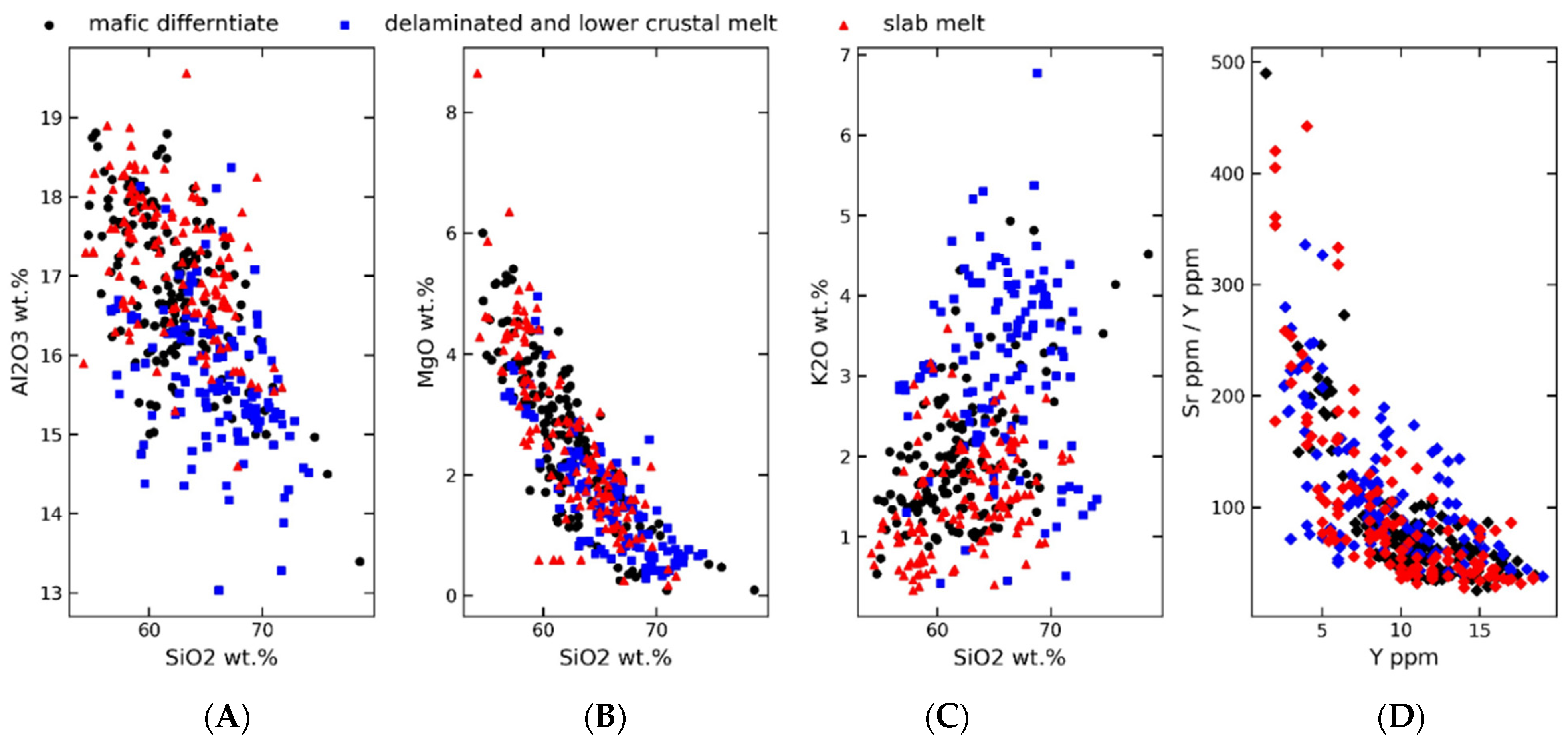
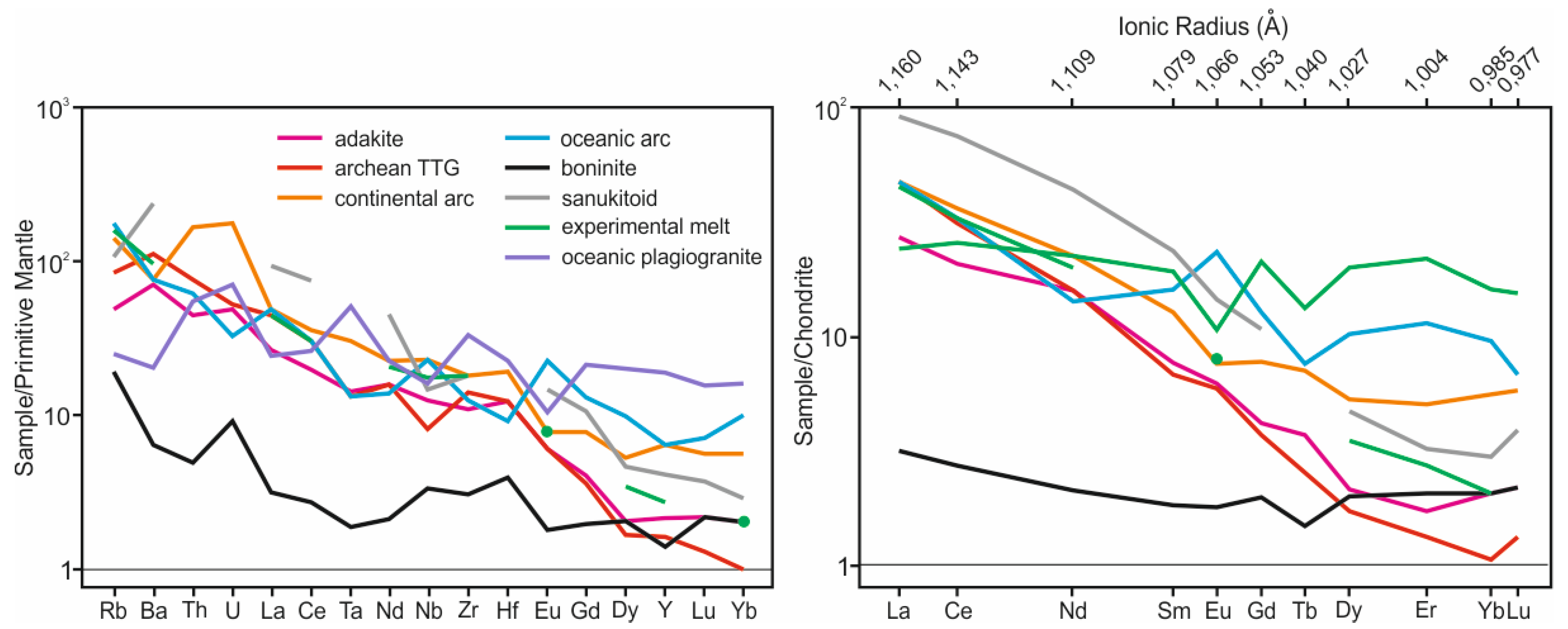
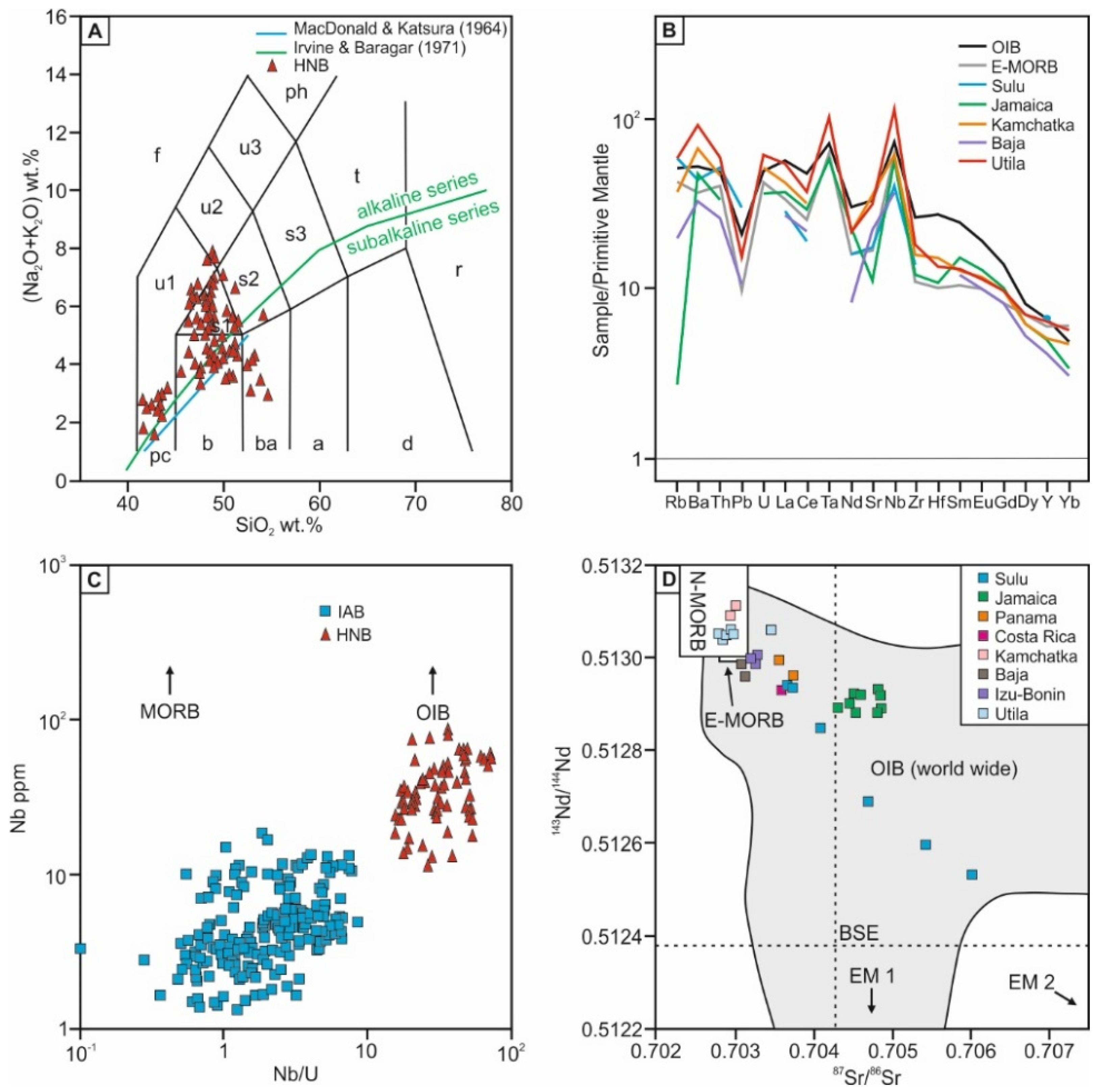
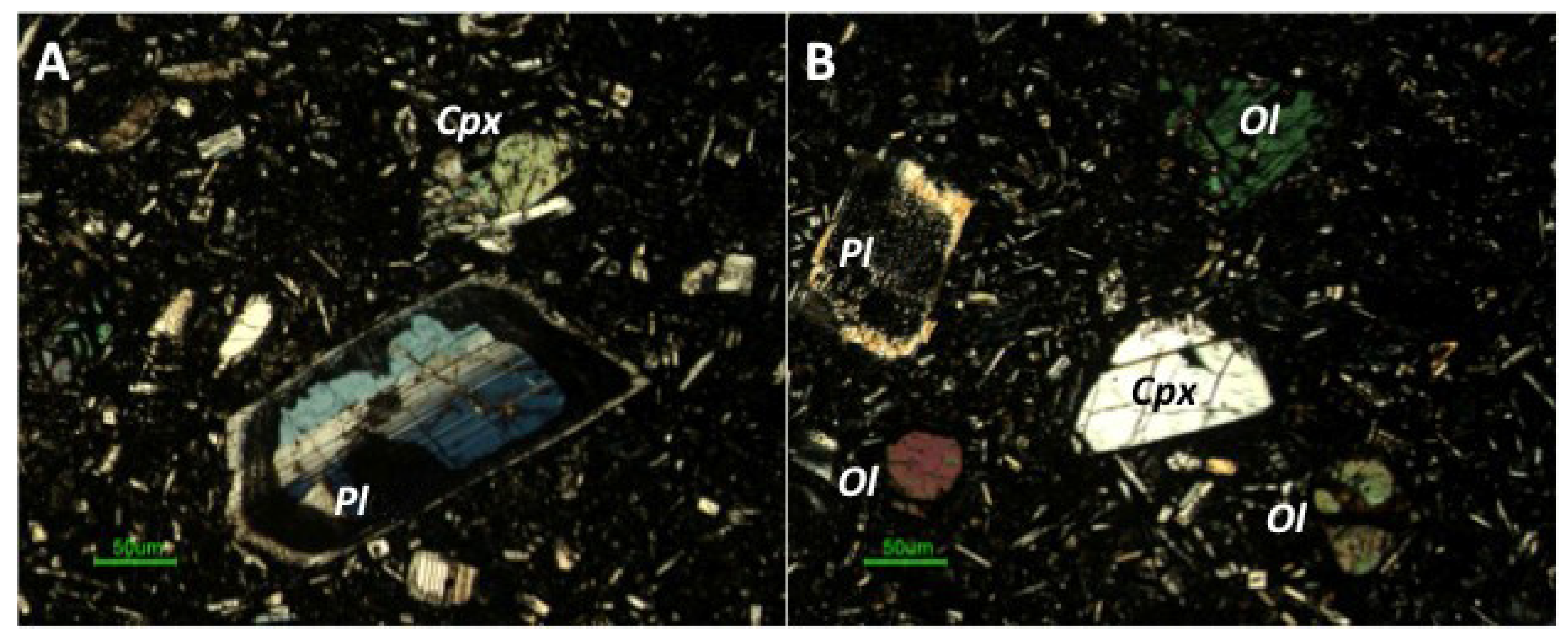
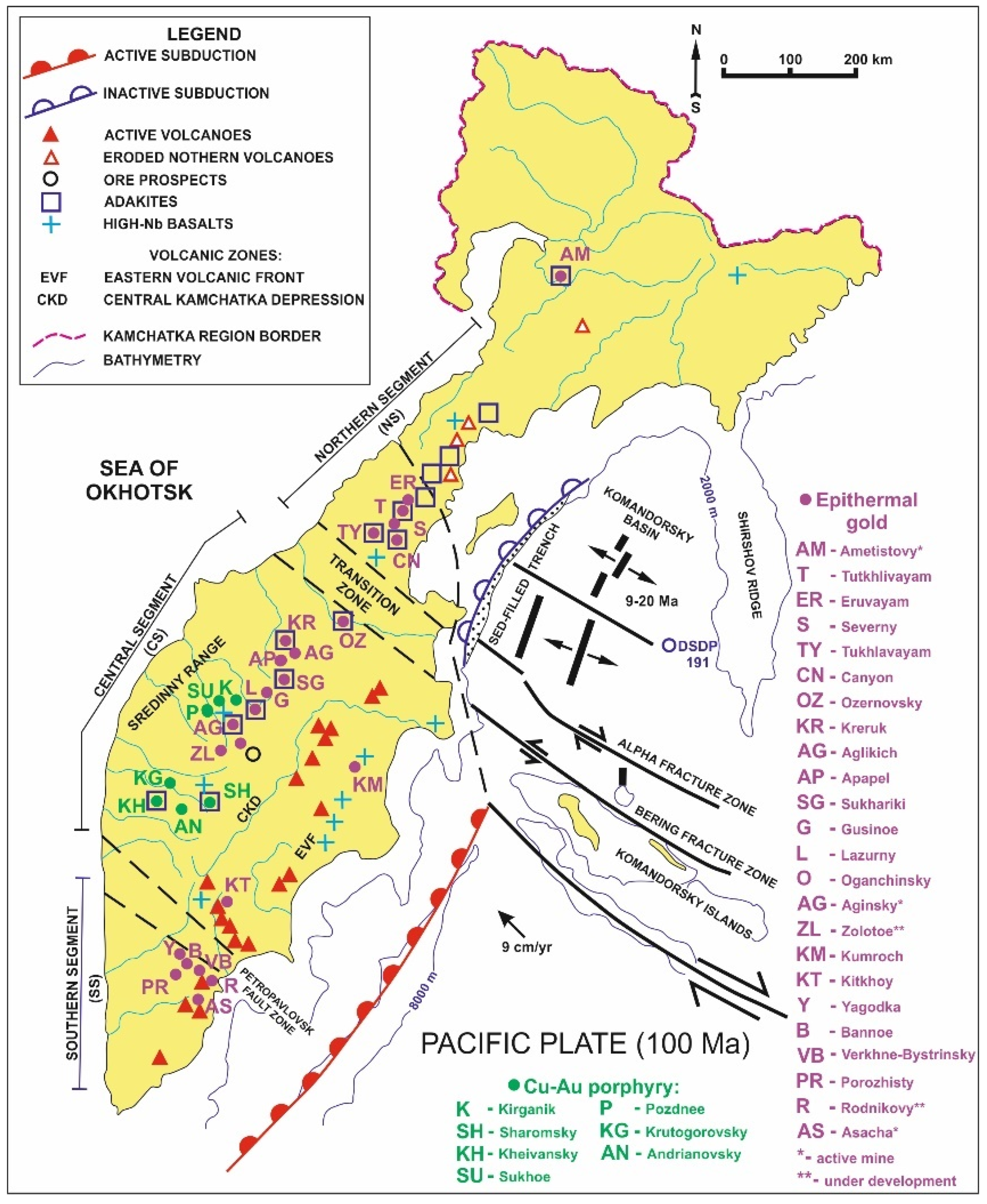
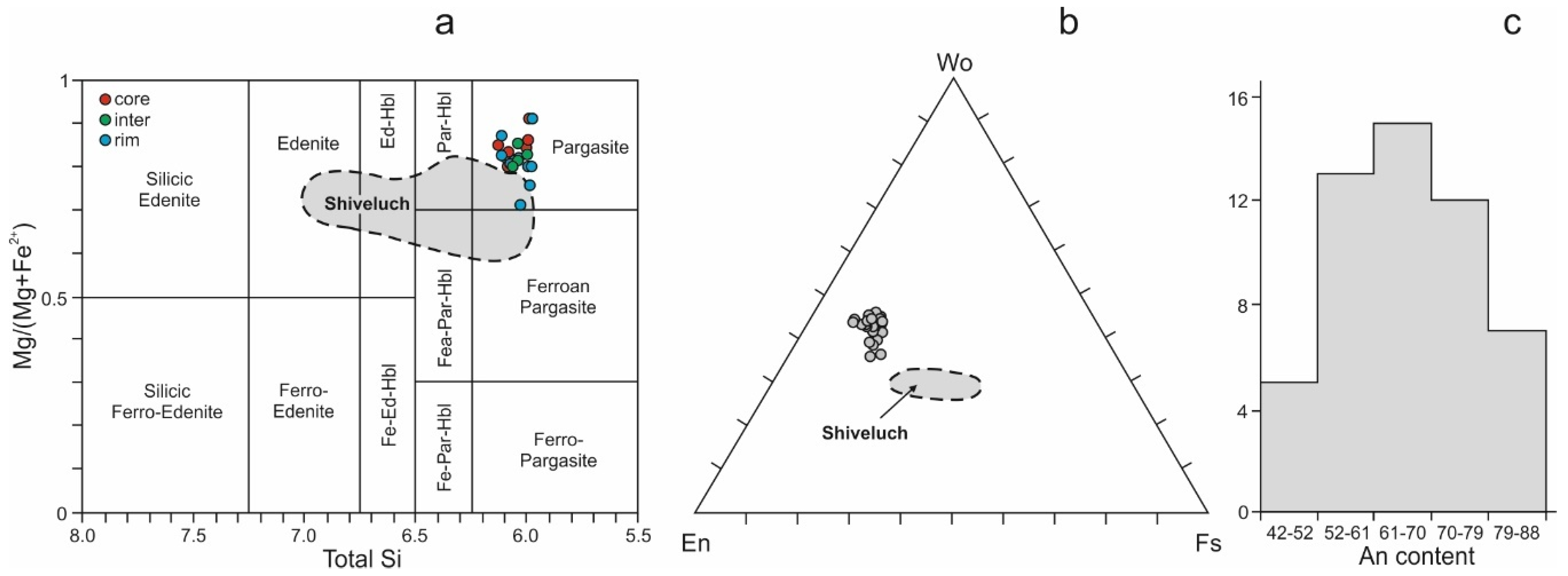


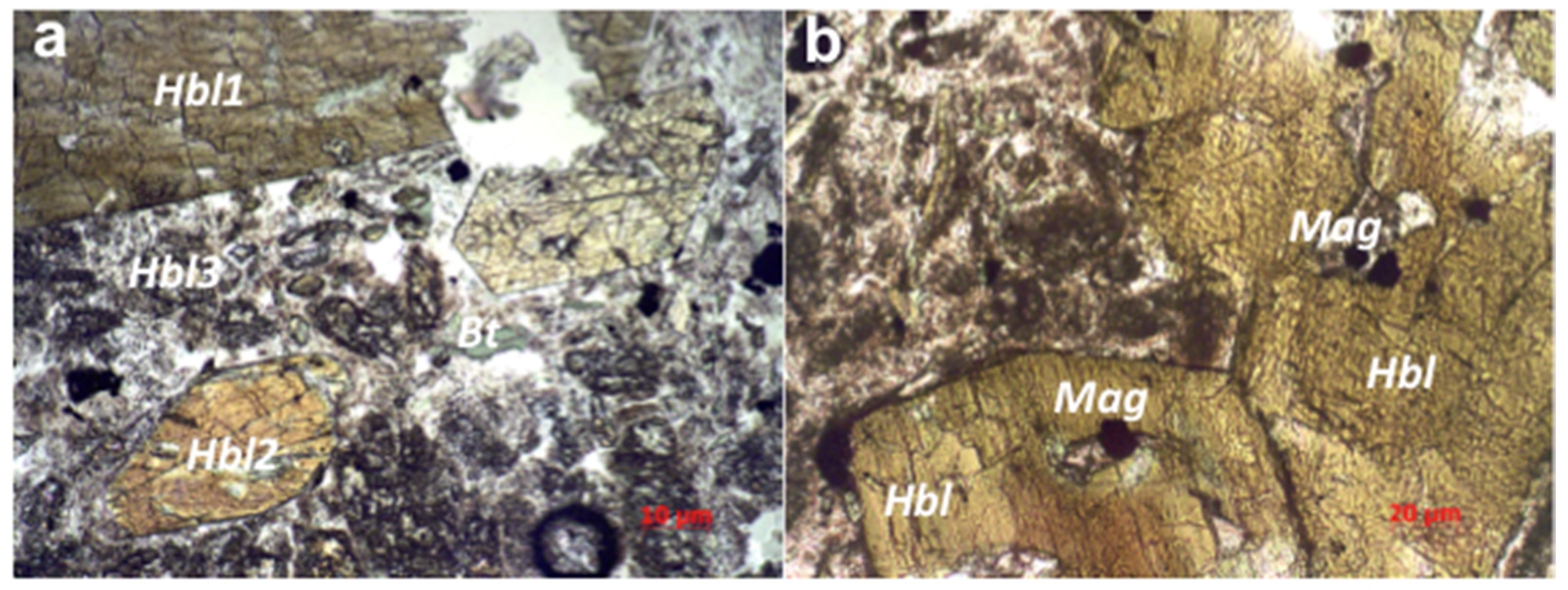
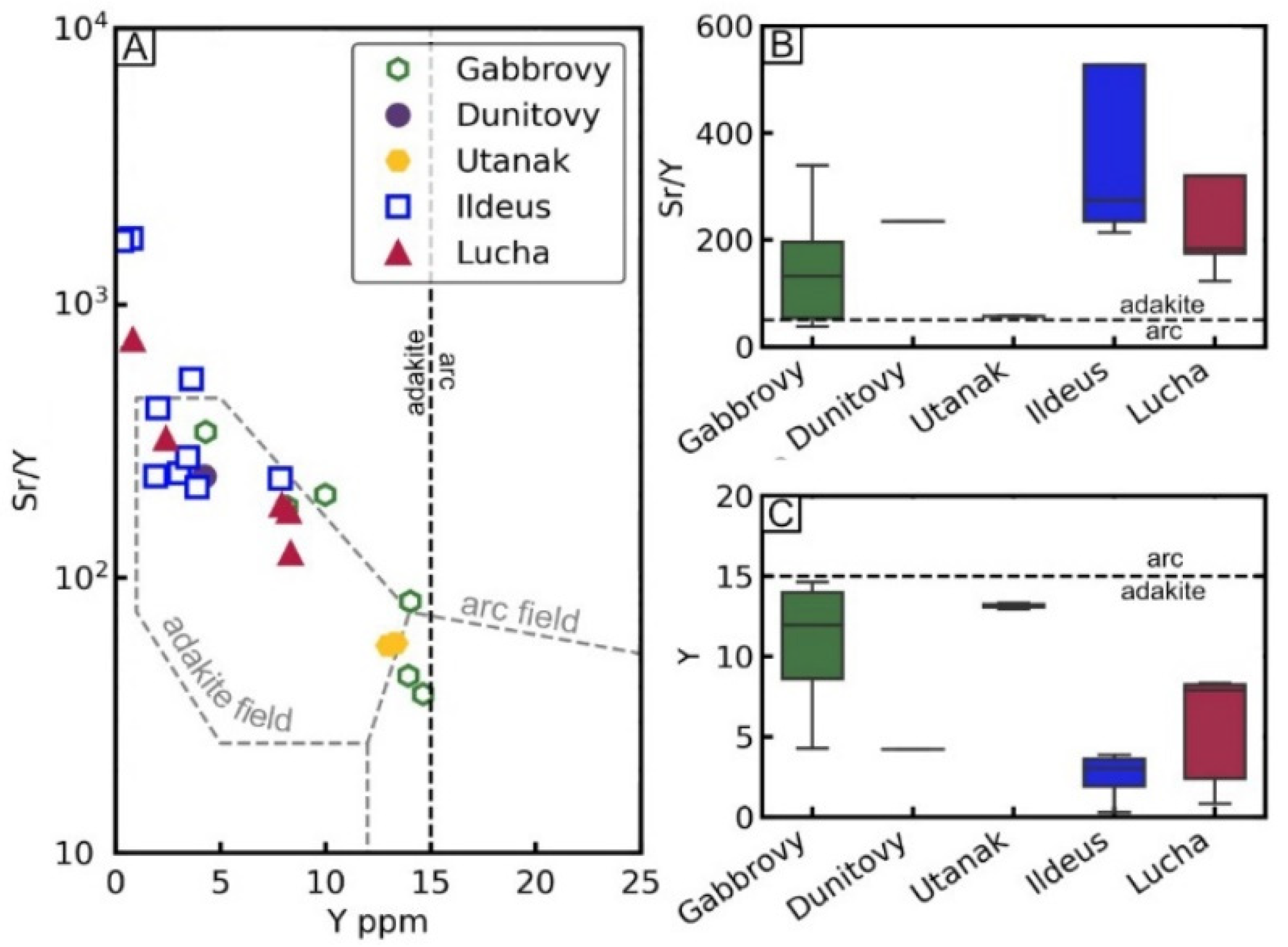
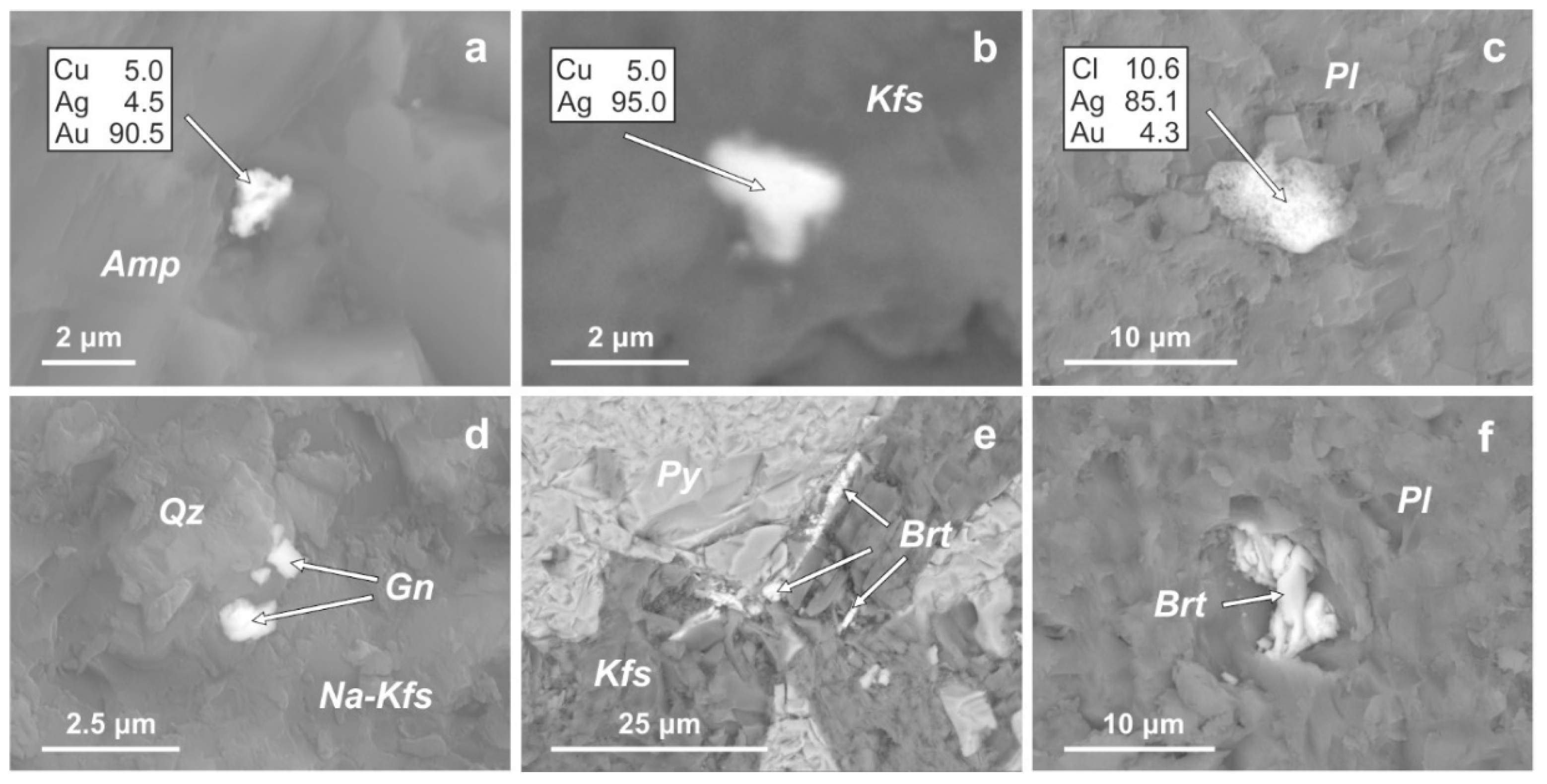
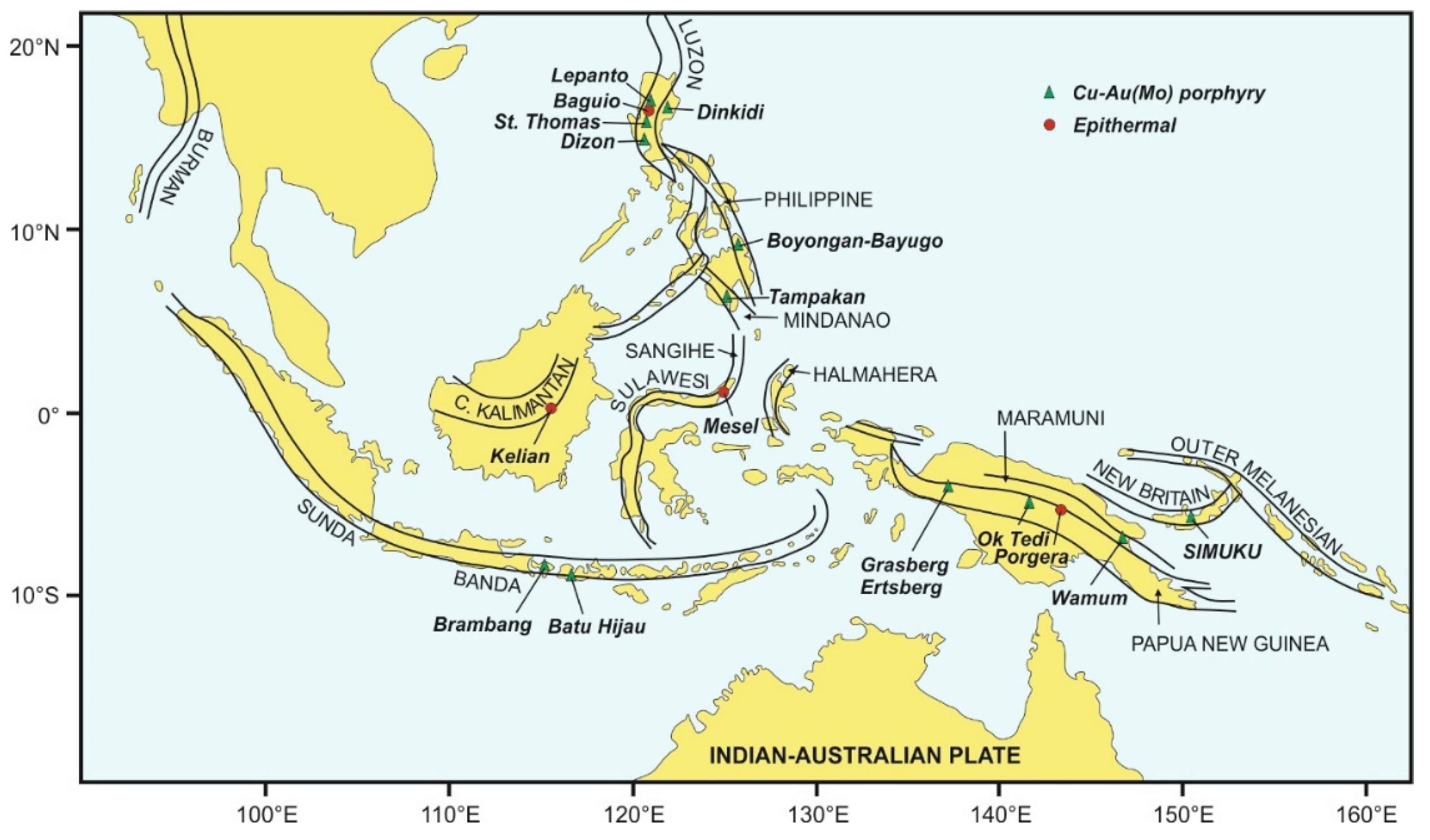

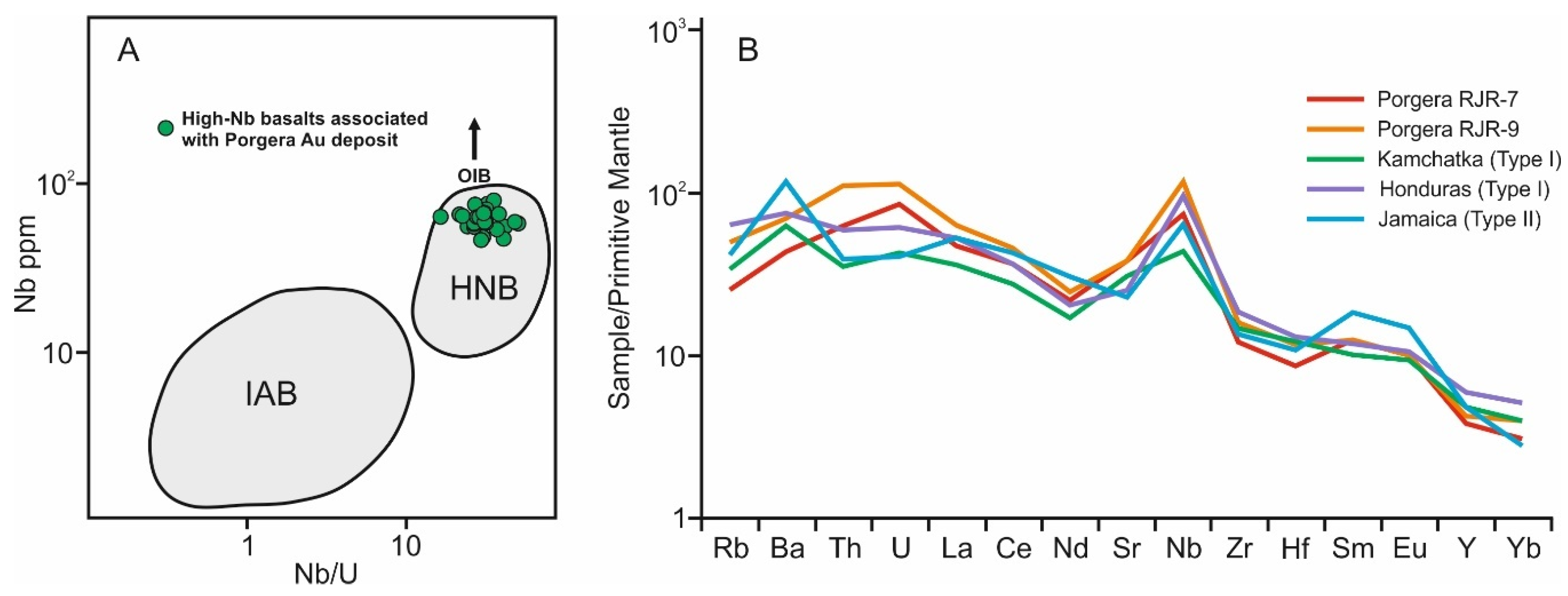
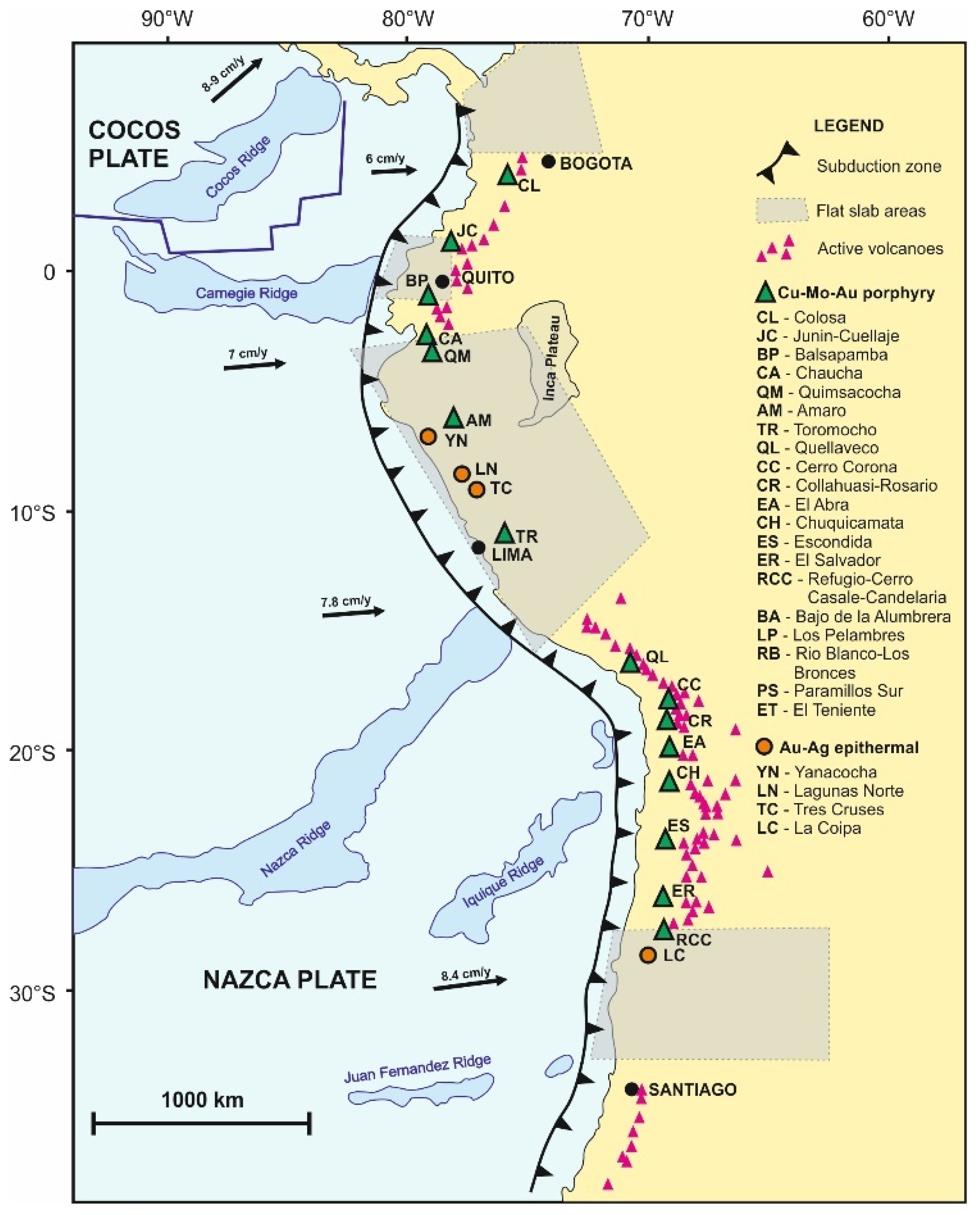
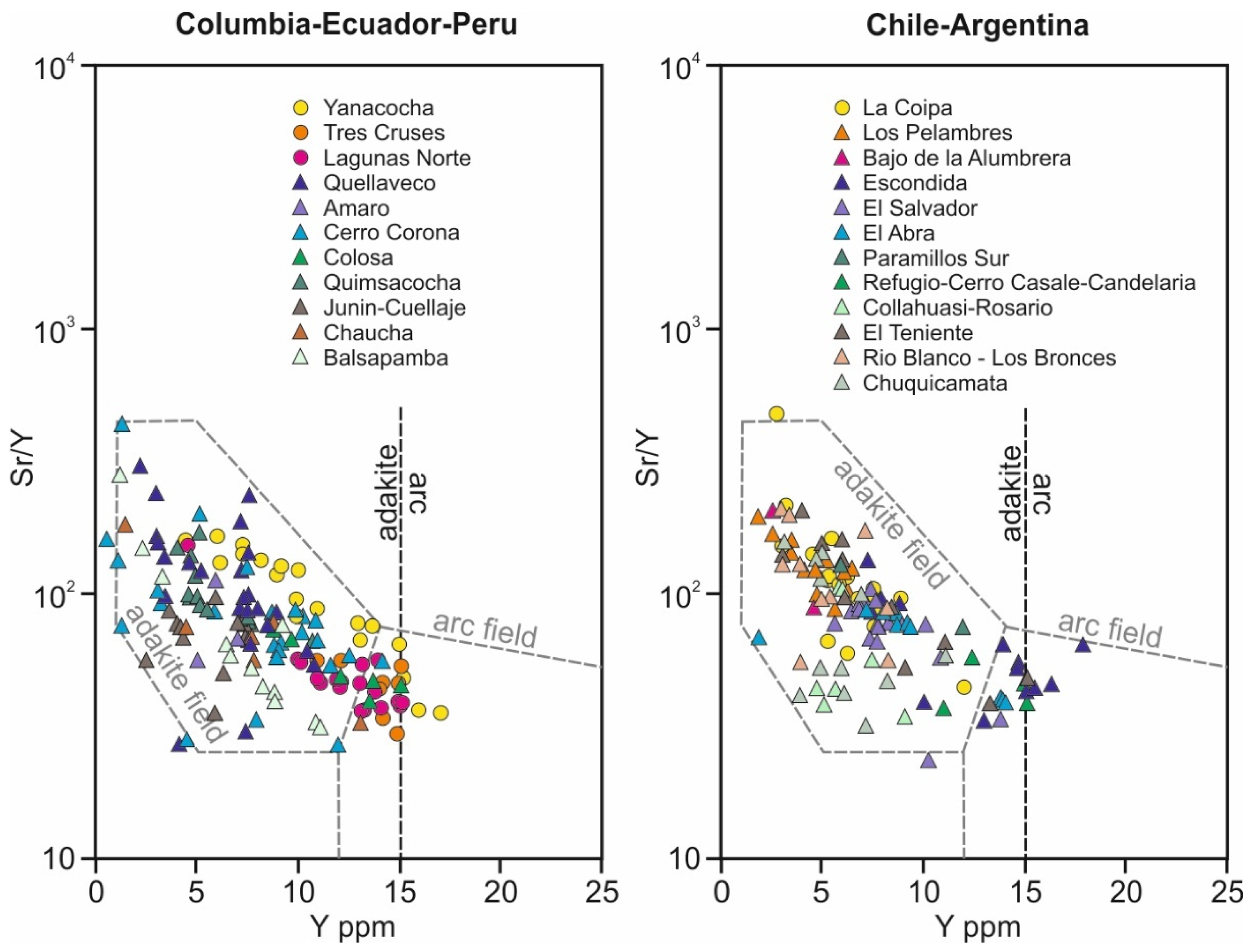
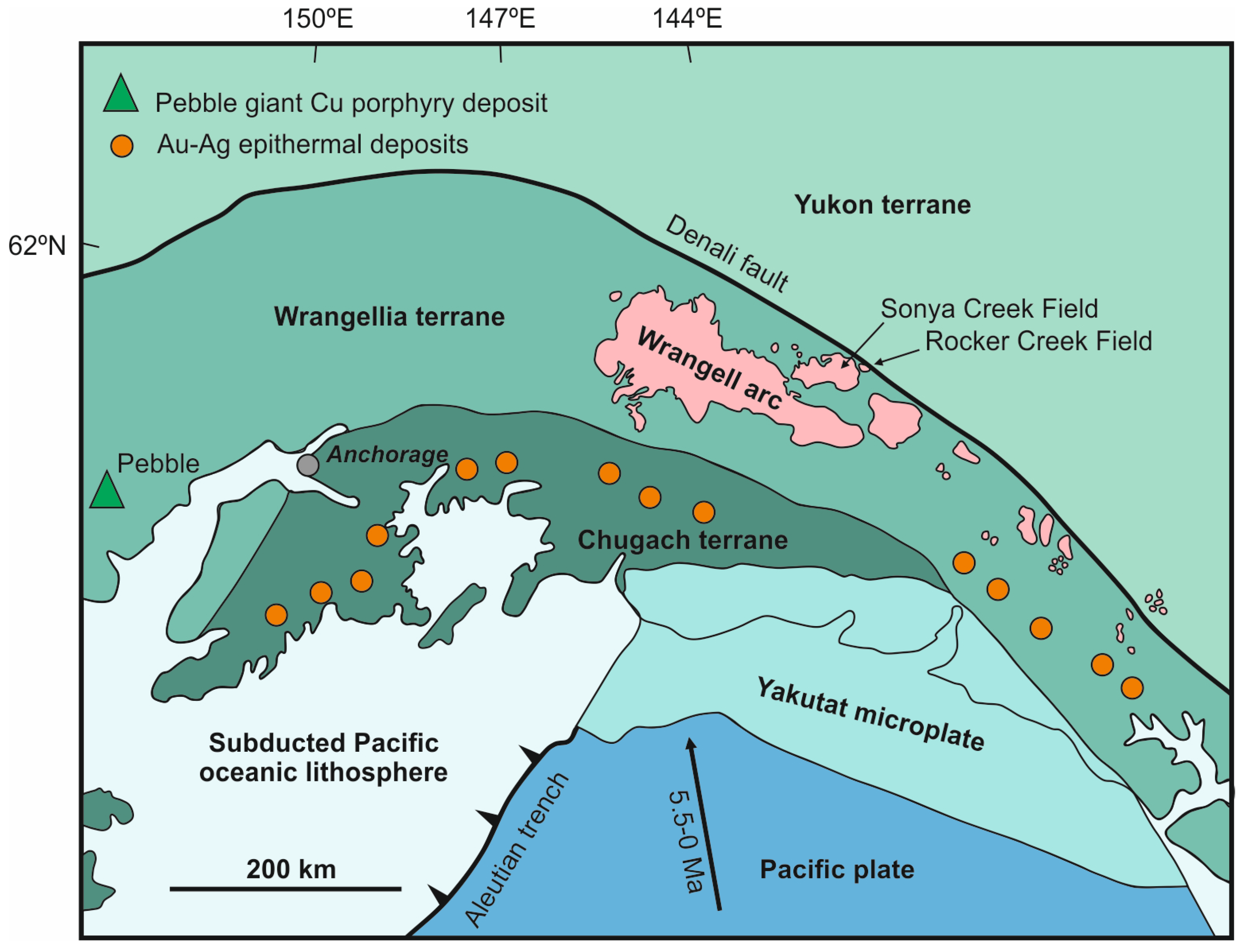
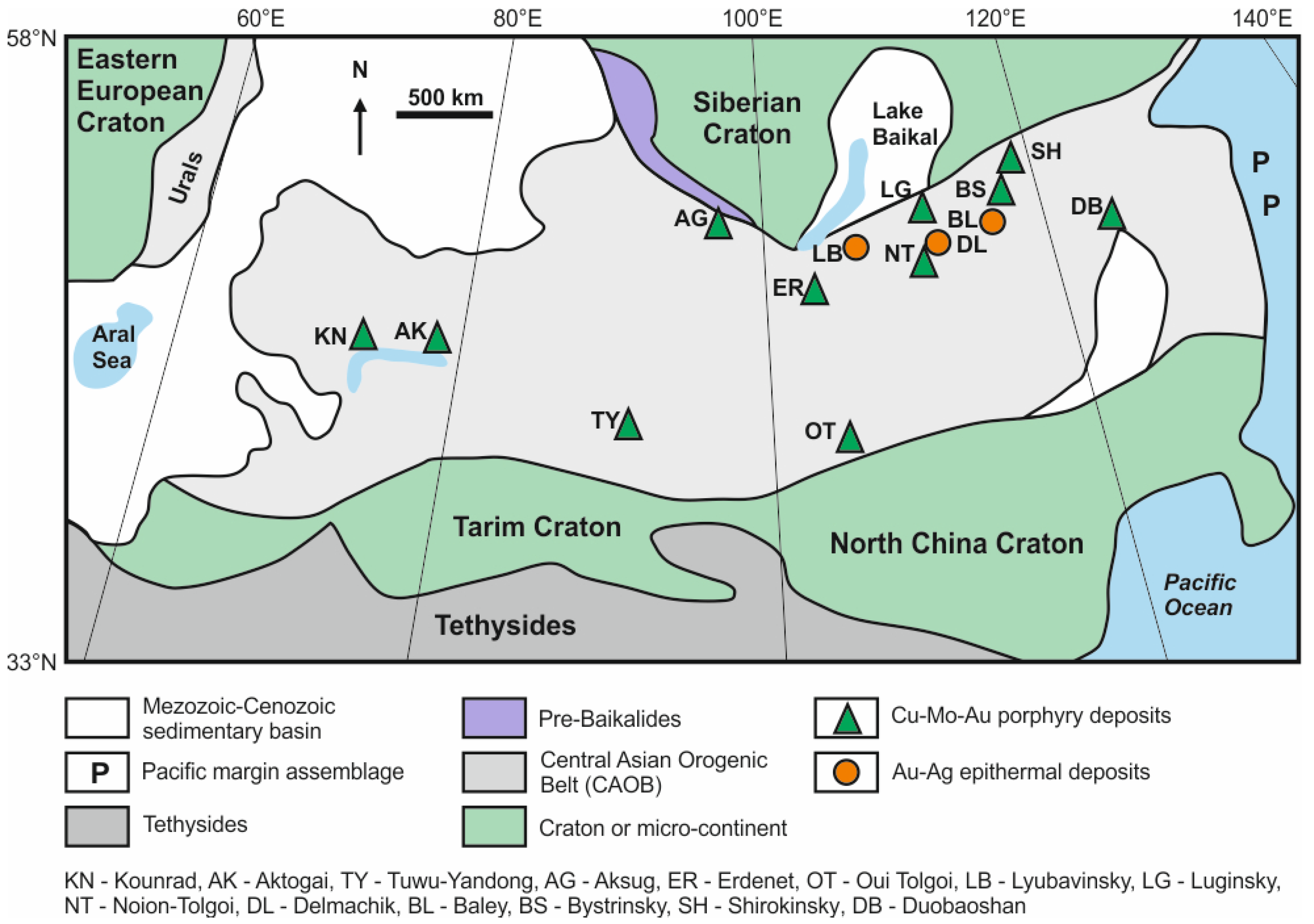

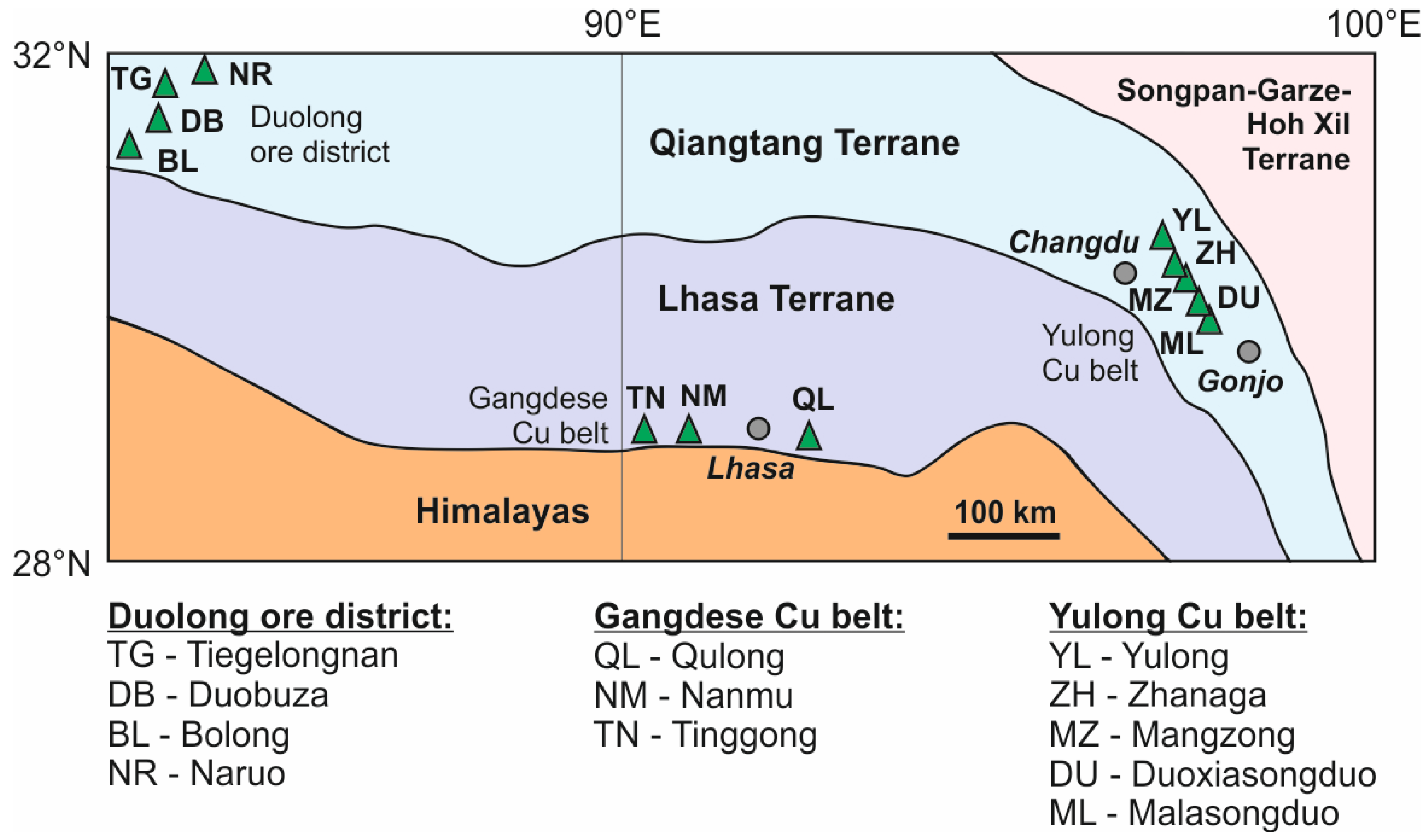

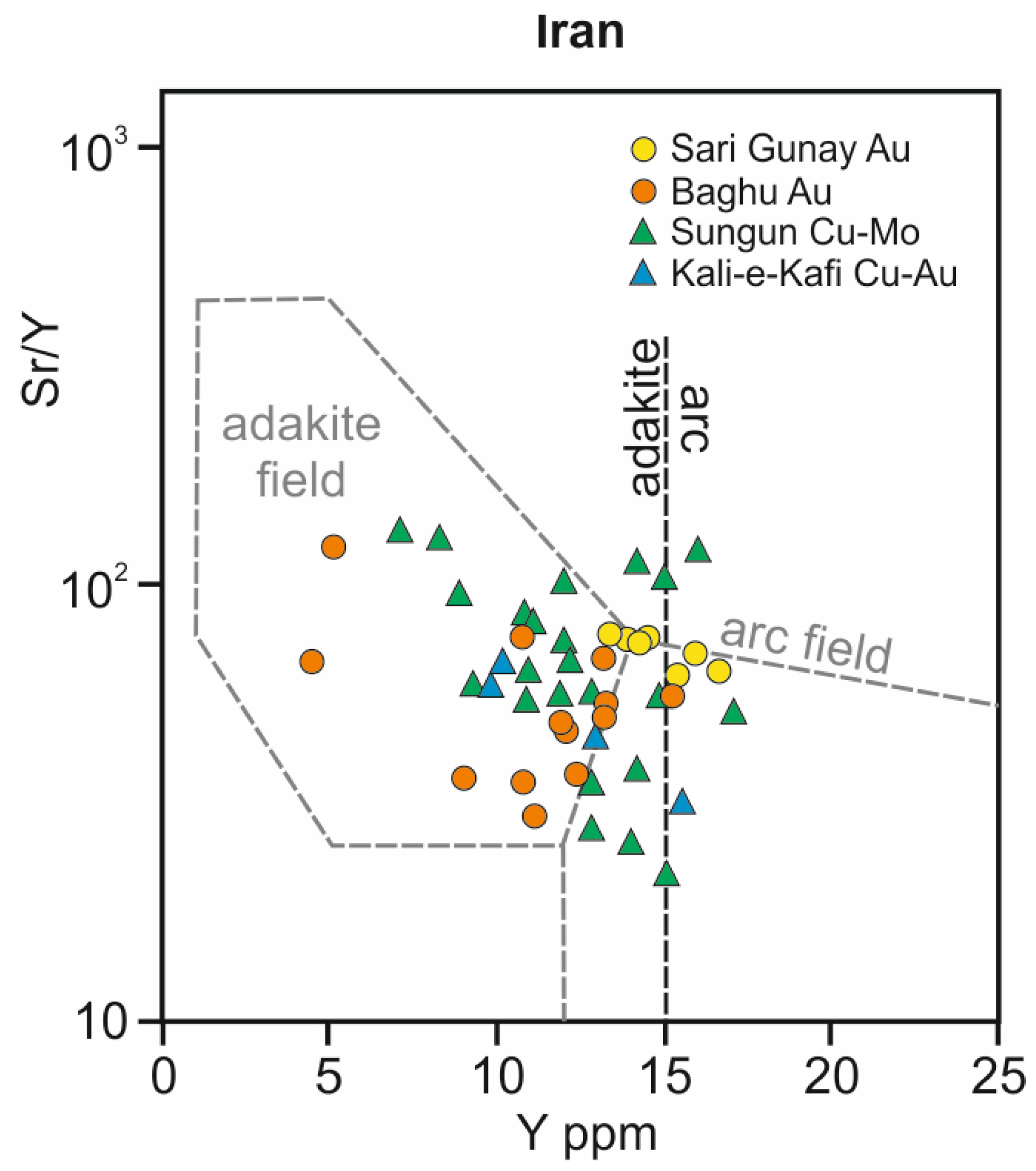
| Adakite Characteristics | Petrologic Interpretations |
|---|---|
| Abundant high- to low-pressure amphibole (multiple populations of megacrysts, phenocrysts and microphenocrysts) | High water content of pristine adakites or multi-stage fractionation under hydrous conditions |
| High SiO2 content (typically > 55 wt.%) | High-P melting of basaltic source (eclogite or garnet amphibolite) |
| High Al2O3 (≥15 wt.%) contents | High-P partial melting of garnet-bearing source (eclogite, garnet amphibolite) |
| High Na2O (>3 wt.%) and Na2O/K2O > 1 | Sodic melts; melting of plagioclase or minor plagioclase in the source |
| High Sr (400–3000 ppm) and absence of negative Eu anomaly | Melting or lack of plagioclase in the residue; plagioclase accumulation during differentiation of primary adakite melts |
| Low MgO (<3 wt.%), low Cr and Ni | Melts from basaltic source; lack of interaction with peridotitic mantle wedge |
| Low Y (≤18 ppm) and Yb (≤1.8 ppm) contents, high Sr/Y (> 30) and La/Yb (>20) ratios | Garnet (also possibly amphibole and clinopyroxene) in the melting residue |
| Low high-field strength element (HFSE) contents (e.g., Nb and Ta) | Residual titanite, rutile or amphibole in the source |
| High Zr/Sm ratio (>100) | Amphibole fractionation or amphibole in the melting residue |
| Low K/La, Rb/La and Ba/La; low 87Sr/86Sr, low 206Pb/204Pb and high 143Nd/144Nd isotope ratios | N-MORB-like basaltic source |
| Oxygen isotopes | Mixing of partial melts from different parts of the slab, or isotope exchange during slab melt–mantle wedge interaction |
| Low δ7Li (+1.4 to +4.2) and low B/Be ratios (5.4 to 7.7) | Melting of a devolatilized MORB slab |
| Highly variable 187Os/188Os isotope ratios | Melting of mafic source or mantle peridotite followed by crustal assimilation |
| Uniform excess of 230Th over 238U combined with variable Th isotopes | Approximately 20% equilibrium melting due to amphibole decomposition in a heterogeneous subducting oceanic slab |
| Tectonic Environment | Geographic Examples | References |
|---|---|---|
| Subduction of young (<25 Ma) oceanic crust | Northern Kamchatka, Philippines, Costa Rica, Peru, Chile | [37,38,45,50,51,52,60,81,91] |
| Ridge (spreading center) subduction | Austral Andes, Panama, Columbia, Ecuador | [37,50,60,81,86] |
| Early stages of subduction/incipient subduction | Mindanao (Philippines), central Inner Mongolia (North China), SW Japan | [43,81,116,117] |
| Flat slab subduction | Southern Ecuador, Peru, Chile, southern Alaska, Hailar Basin (NE China) | [105,118,119,120] |
| Oblique subduction | Central Aleutians (Adak), Panama. Solander Island (New Zealand), Wrangell Arc (1) (South Alaska) | [31,47,49,60,121,122] |
| Duplicate (overlapping) slabs | Central Japan | [123] |
| Transform faulting and slab tear | Central Kamchatka, Western Aleutians, Southern Tibet | [124,125,126] |
| Melting of mafic lower crust or underplated oceanic crust | Highlands of Papua New Guinea, Tibet | [39,67,68,70,72,73] |
| Post-subduction slab window, upwelling of asthenospheric mantle, slab break-off | Camaguin Island (Philippines), Baja California | [74,79,126,127] |
| Post-collisional and intracontinental (cratonic) extension | Tibet, North China craton, Dabie orogen, Dexing (South China) | [69,72,73,90,106,109] |
| Location | Kamchatka | Panama | Baja California | Philippines | Jamaica | Sulu | Utila, Honduras | Izu-Bonin |
|---|---|---|---|---|---|---|---|---|
| Age | 7 Ma | 2.35 Ma | 9.47 Ma | 1.98 Ma | ~52 Ma | Pliocene- Pleistocene | Late Pleistocene | 0.43 Ma |
| Sample# | VAL55 | P-26 | 99–131 | PH93-39 | AHWG08 | SBK13 | UTI1715 | FK-15 |
| Ref. | [52] | [56] | [55] | [59] | [129] | [130] | [131] | [132] |
| SiO2 (wt.%) | 48.08 | 45.5 | 49.00 | 53.20 | 51.21 | 49.44 | 48.83 | 48.53 |
| TiO2 | 2.03 | 2.27 | 1.67 | 1.73 | 3.05 | 2.07 | 1.60 | 1.69 |
| Al2O3 | 15.89 | 12.6 | 14.86 | 14.50 | 16.73 | 15.81 | 17.26 | 17.01 |
| Fe2O3 | 10.20 | 11.0 | 11.50 | 11.20 | 9.08 | 11.35 | 9.86 | 11.75 |
| MnO | 0.16 | 0.15 | 0.15 | 0.16 | 0.14 | 0.17 | 0.18 | 0.18 |
| MgO | 8.51 | 10.90 | 9.10 | 7.50 | 4.21 | 7.66 | 6.04 | 7.77 |
| CaO | 9.67 | 11.70 | 7.80 | 8.60 | 9.06 | 8.95 | 8.07 | 9.31 |
| Na2O | 3.01 | 2.65 | 3.60 | 2.89 | 4.64 | 2.97 | 3.61 | 3.01 |
| K2O | 1.96 | 1.10 | 1.15 | 0.54 | 0.62 | 1.20 | 2.34 | 1.11 |
| P2O5 | 0.50 | 1.00 | 0.35 | 0.24 | 0.77 | 0.35 | 0.56 | 0.31 |
| LOI | 0.00 | 0.40 | 0.63 | 0.18 | 0.84 | 1.01 | 0.19 | |
| Total | 100.04 | 99.27 | 99.86 | 100.50 | 99.51 | 99.97 | 99.36 | 100.67 |
| Cr (ppm) | 339 | 299 | 274 | 62 | 231.2 | 170 | 144 | |
| Ni | 136 | 218 | 190 | 70 | 136.0 | 68 | 101 | |
| V | 281 | 190 | 204 | 240.1 | 152 | 216 | ||
| Rb | 22 | 22 | 14.6 | 9.3 | 2.7 | 28.5 | 41.47 | 27.0 |
| Ba | 448 | 800 | 255 | 89 | 823 | 308 | 532 | 356 |
| Sr | 667 | 1200 | 495 | 298 | 489 | 388.4 | 528 | 566 |
| Zr | 162 | 160 | 128 | 153.5 | 160.7 | 199 | 111 | |
| Y | 22 | 22 | 18.5 | 23.4 | 22.2 | 24.9 | 27.2 | 19.7 |
| Nb | 32.1 | 51 | 26.5 | 25.8 | 47.21 | 35.2 | 71.19 | 24.5 |
| Ta | 2.73 | 3.83 | 1.37 | |||||
| Hf | 3.7 | 3.39 | 3.99 | 2.76 | ||||
| Th | 3.0 | 5.8 | 3.37 | 2.8 | 5.03 | 2.42 | ||
| U | 0.9 | 1.6 | 0.88 | 1.29 | 0.62 | |||
| La | 25.0 | 53.9 | 19.5 | 6.5 | 35.97 | 15.2 | 36.28 | 18.3 |
| Ce | 49.3 | 112.0 | 41 | 15.5 | 77.74 | 37.7 | 65.01 | 34.0 |
| Nd | 23.1 | 58.9 | 22 | 13.5 | 41.36 | 20.8 | 27.91 | 19.9 |
| Sm | 4.6 | 10.1 | 5.3 | 8.32 | 5.37 | 4.51 | ||
| Eu | 1.58 | 3.16 | 1.6 | 1.35 | 2.52 | 1.75 | 1.52 | |
| Gd | 4.6 | 8.6 | 4.6 | 6.59 | 5.29 | 4.64 | ||
| Tb | 1.1 | 0.88 | 0.82 | 0.72 | ||||
| Dy | 3.9 | 5.3 | 3.7 | 4.4 | 4.37 | 4.84 | 4.40 | |
| Ho | 0.96 | 0.70 | 0.96 | 0.88 | ||||
| Er | 2.3 | 1.8 | 2 | 1.78 | 2.76 | 2.50 | ||
| Tm | 0.3 | 0.25 | 0.401 | 0.35 | ||||
| Yb | 2.0 | 2.0 | 1.42 | 1.7 | 1.44 | 2.57 | 2.27 | |
| Lu | 0.30 | 0.24 | 0.11 | 0.39 | 0.33 | |||
| Nb/La | 1.28 | 0.95 | 1.36 | 3.97 | 1.31 | 2.32 | 1.96 | |
| Nb/U | 35.7 | 31.9 | 53.7 | 55.2 | ||||
| Zr/Sm | 35.2 | 15.9 | 18.5 | 37.1 | ||||
| 87Sr/86Sr | 0.703010 | 0.703555 | 0.703135 | 0.703360– 0.703627 (1) | 0.70445 (2) | 0.704092 | 0.70284 | 0.7040.56 |
| 143Nd/144Nd | 0.513110 | 0.512994 | 0.512955 | 0.512942– 0.512996 (1) | 0.51290 (2) | 0.512846 | 0.51305 | 0.512828 |
| 206Pb/204Pb | 18.4910 | 18.702 | 18.528 | 18.741 | 18.1677 | |||
| 207Pb/204Pb | 15.6140 | 15.570 | 15.566 | 15.541 | 15.5389 | |||
| 208Pb/204Pb | 38.6370 | 38.598 | 38.145 | 38.3893 |
| Sample | Val-4 | Val-4 | Val-4 | Val-4 | Val-29 | Val-29 | Val-29 | Val-29 |
|---|---|---|---|---|---|---|---|---|
| Mineral | Amp | Amp | Pl | Pl | Cpx | Cpx | Amp | Pl |
| SiO2 | 42.37 | 41.30 | 47.84 | 50.87 | 47.34 | 52.56 | 40.89 | 46.36 |
| TiO2 | 2.71 | 2.61 | ND | ND | 1.97 | 0.37 | 3.47 | ND |
| Al2O3 | 13.44 | 14.36 | 33.50 | 31.42 | 9.69 | 1.86 | 14.81 | 33.96 |
| FeO | 9.71 | 12.28 | 0.51 | 0.62 | 6.70 | 8.46 | 10.87 | 0.44 |
| MnO | 0.34 | 0.20 | ND | ND | 0.34 | 0.37 | 0.47 | ND |
| MgO | 15.03 | 13.39 | ND | ND | 13.52 | 15.83 | 13.73 | ND |
| CaO | 11.07 | 11.25 | 16.01 | 13.54 | 19.78 | 20.17 | 10.92 | 16.53 |
| Na2O | 2.14 | 2.15 | 2.41 | 3.80 | 0.83 | 0.27 | 2.61 | 1.98 |
| K2O | 0.20 | 0.21 | 0.06 | 0.06 | 0.00 | 0.00 | 0.42 | 0.01 |
| BaO | ND | ND | 0.17 | 0.03 | ND | ND | ND | 0.08 |
| Total | 97.01 | 97.75 | 100.35 | 100.34 | 100.17 | 99.89 | 98.19 | 99.36 |
| Mg-number | 75.4 | 67.7 | - | - | 78.3 | 77.0 | 71.2 | - |
| An content | - | - | 78.3 | 66.1 | - | - | - | 82.1 |
| Deposits | Age (Ma) | Magmatism | Mineralization | Grades | Resources |
|---|---|---|---|---|---|
| Ametistovy | 38–41 Ma | Adakite nested caldera | 38 Qz veins (1–20 m) with Py, Mrc, Ccp, Sp, Gn, Tnt-Ttr, El. Argn. Pol | Au = 13.62 g/t; Ag = 84 g/t | Au—1.8 Moz; Ag—8 Moz |
| Ozernovsky | 7.6 Ma | Adakite nested caldera | Qz–Adl veins (1–11 m); silicic stockwork with | Au = 8.7–16.6 g/t | Au—2.7 Moz |
| Tutkhlyvayam | Miocene | Adakite, calc-alkaline andesite and dacite | Qz–Cb veins (22 in total) | Au = 9.6–11.2 g/t; Ag = 135–531 g/t | Au—1.6 Moz; Ag—36 Moz |
| Tymlat | Miocene | Adakite, granite porphyry | Argyllized shear zones (5–23 m) with Py+Apy; Py–Hem–Ccp silicic stockwork | Au~3 g/t; also Cu—0.36–0.5% | Au—0.7 Moz |
| Severny | Miocene | Adakitic diorite porphyry | Qz and Qz–Cb veins (1.5–4.3 m) and silicic (with Ccp, Py, Sp, Au, Hes, Tnt-Ttr) stockwork | Au = 23.2 g/t; Ag = 68.9 g/t | Au—0.41 Moz; Ag—1.2 Moz |
| Eruvayam | Miocene | Adakite porphyry and CA volcanics | 19 Qz–Cb (±Adl) veins (0.2–18 m) | Au = 8–10.6 g/t; Ag = 5–173.8 g/t | Au—1 Moz; Ag—31 Moz |
| Canyon | Miocene | Adakite porphyry | 30 Qz and Qz–Cb veins and stockwork zones (0.6–16 m) with Py, Gn, Ccp, Sp, Au, Hes, Argn, Tnt-Ttr, Pyr | Au = 2.2–281.6 g/t; Ag = 2.9–1450 g/t | Au—0.6 Moz; Ag—13.3 Moz |
| Kreruk | Pliocene | Adakite volcanics | Qz and Qz–Cb veins (0.5–4 m) with Au, Argn, Sp, Tnt-Ttr, Antm | Au = 10.9–93.3 g/t; Ag = 138.8–1109.1 g/t | Au—0.5 Moz; Ag—10 Moz |
| Apapel | Pliocene | Subvolcanic adakitic rhyolite | 11 Qz veins (0.2–8.8 m) with Au, Py, Mrc, Sp, Mol, Cin | Au = 12.6–102.1 g/t; Ag = 11.9–120.3 g/t | Au—0.5 Moz; Ag—3 Moz |
| Aglikich | Miocene- Pliocene | Adakite porphyry | 11 Qz–Cb–Adl–Zeo veins (0.3–7.5 m) with Au, Hes, Ccp, Tnt-Ttr, Mag, Mrc, Cv | Au = 7.1–63.8 g/t; Ag = 42.5–651.8 g/t | Au—0.5 Moz; Ag—3 Moz |
| Verkhne-Sukhariki | Miocene | Nested caldera with adakites | 18 Qz and Qz–Cb veins (0.1–5 m) within silicic to argyllic envelope with Au, Py, Mrc, Ccp, Tnt–Ttr | Au = 4.7–11.8 g/t; Ag = 3.9–11.4 g/t | Au—1.4 Moz |
| Marina | Miocene Pliocene | Nested caldera with adakites | Silicic metasomatites (4–25 m) with Qz, Cb, Adl, Adl–Cb–Qz and Qz–Cb veining (Au, Argn, Py, Ccp, Sp, Tnt–Ttr) | Au = 1.2–35 g/t; Ag = 1.6–115 g/t | Au—0.3 Moz; Ag—0.6 Moz |
| Sukharikovsky Grebny | Miocene | Nested caldera with adakites and ignimbrites | Multiple (13) Qz–Adl–Cb metasomatic zones (1–16 m) with Au, Ag, Argn, Ccp, Sp, Gn, Pol, Hes, Syl | Au = 7 g/t; Ag = 22.7 g/t | Au—0.9 Moz; Ag—5.2 Moz |
| Kirganik | 73.17 ± 0.54 Ma | Shoshonites with minor adakite and HNB | Metasomatic zones (20–40 m) with Ccp, Bn, Cct, Hem, Mag, Dg, Sp, Gn, Mer | Cu = 0.5–0.71%; Au = 0.5–0.75 g/t; Ag = 6–7 g/t; Pt + Pd = 1.8 g/t | Cu—905,000 t; Au—3.1 Moz; Ag—32.7 Moz; Pt+Pd—2.02 Moz |
| Malachitovy (Lavlinsky ore field) | Miocene | Calc-alkaline andesite and dacite porphyry with minor adakite | Metasomatic and linear stockwork zones with Ccp, Bn, Cct, Dg, Hem, Mag | Cu = 0.17–0.47%; Au = 0.02 g/t; Ag~1.3 g/t; Mo~0.014% | Cu—3,539,000 t; Au—17.2 Moz |
| Sample | UTN-7 | UTN-7 | UTN-7 | UTN-7 | LU-9 | LU-9 | LU-9 | LU-9 |
|---|---|---|---|---|---|---|---|---|
| Mineral. | Amp | Amp | Amp | Pl | Amp | Amp | Bt | Pl |
| SiO2 | 45.55 | 47.48 | 49.98 | 55.96 | 44.43 | 48.20 | 38.70 | 54.44 |
| TiO2 | 1.51 | 0.80 | 0.58 | 0.00 | 2.53 | 1.45 | 3.17 | 0.13 |
| Al2O3 | 11.45 | 10.13 | 9.19 | 27.25 | 12.76 | 8.43 | 15.27 | 27.89 |
| Cr2O3 | 0.46 | 0.03 | 0.04 | 0.00 | 0.43 | 0.07 | 0.18 | 0.00 |
| FeO | 10.78 | 10.80 | 15.95 | 0.21 | 11.53 | 10.68 | 15.10 | 0.21 |
| MnO | 0.15 | 0.20 | 0.21 | 0.00 | 0.18 | 0.24 | 0.17 | 0.02 |
| MgO | 14.36 | 15.08 | 11.24 | 0.01 | 13.43 | 15.78 | 14.96 | 0.03 |
| CaO | 11.33 | 11.14 | 9.17 | 9.78 | 10.89 | 10.59 | 0.13 | 11.25 |
| Na2O | 1.98 | 1.94 | 1.47 | 5.49 | 2.31 | 1.67 | 0.79 | 5.09 |
| K2O | 0.41 | 0.23 | 0.26 | 0.15 | 0.31 | 0.21 | 7.97 | 0.12 |
| Total | 97.98 | 97.83 | 98.09 | 98.86 | 98.80 | 97.32 | 96.44 | 99.18 |
| Mg-number | 70.4 | 71.3 | 55.7 | - | 67.5 | 72.5 | 63.4 | - |
| An content | - | - | - | 49.1 | - | - | - | 54.7 |
| Location | Ildeus | Ildeus | Ildeus | Lucha | Gabbrovy | Gabbrovy | Utanak |
|---|---|---|---|---|---|---|---|
| Sample # | 042F | 016H | 047F | LU-9 | GAB-8 | GAB-8A | UTN-7 |
| SiO2 (wt.%) | 62.40 | 72.16 | 71.48 | 68.85 | 62.01 | 60.73 | 57.89 |
| TiO2 | 0.13 | 0.20 | 0.17 | 0.09 | 0.25 | 0.78 | 0.83 |
| Al2O3 | 12.40 | 13.35 | 13.27 | 15.42 | 15.23 | 15.78 | 14.80 |
| Fe2O3 | 4.17 | 2.05 | 1.78 | 1.31 | 5.16 | 5.24 | 7.42 |
| MnO | 0.08 | 0.03 | 0.03 | 0.04 | 0.09 | 0.09 | 0.13 |
| MgO | 1.82 | 1.34 | 1.77 | 1.06 | 3.33 | 3.48 | 4.16 |
| CaO | 8.55 | 2.20 | 2.51 | 1.36 | 4.59 | 4.50 | 6.12 |
| Na2O | 6.56 | 7.80 | 7.70 | 7.11 | 4.21 | 4.63 | 4.74 |
| K2O | 3.12 | 0.61 | 0.48 | 3.62 | 3.82 | 3.63 | 2.49 |
| P2O5 | 0.05 | 0.04 | 0.09 | 0.04 | 0.23 | 0.26 | 0.33 |
| LOI | 0.72 | 0.31 | 0.55 | 0.55 | 0.58 | 0.48 | 1.06 |
| Total | 100.00 | 99.92 | 99.85 | 99.45 | 100.00 | 99.99 | 99.97 |
| Cr (ppm) | 525 | 142 | 83.9 | 74.4 | 79.8 | 57.5 | 63.9 |
| Ni | 237 | 36.1 | 30.0 | 43.1 | 12.9 | 12.1 | 37.0 |
| Co | 28.3 | 16.6 | 13.4 | 10.9 | 17.5 | 17.1 | 21.4 |
| Cu | 21.0 | 32.5 | 28.3 | 42.9 | 18.7 | 20.2 | 28.1 |
| Zn | 155 | 31.6 | 23.7 | 131 | 72.8 | 70.9 | 86.0 |
| Sc | 5.67 | 2.14 | 0.82 | 1.92 | 7.98 | 7.37 | 10.9 |
| V | 23.6 | 36.2 | 15.9 | 8.12 | 96.6 | 83.2 | 105 |
| Cs | 0.16 | 0.11 | 0.09 | 0.25 | 1.78 | 1.41 | 0.62 |
| Li | 1.16 | 1.82 | 2.37 | 2.68 | 10.03 | 9.68 | 5.69 |
| Rb | 37.1 | 5.15 | 3.81 | 26.0 | 84.4 | 81.1 | 51.2 |
| Ba | 5777 | 598 | 336 | 2085 | 901 | 953 | 926 |
| Sr | 447 | 830 | 827 | 768 | 552 | 614 | 735 |
| Zr | 2.78 | 3.18 | 0.97 | 10.6 | 16.5 | 14.5 | 95.4 |
| Y | 1.91 | 3.88 | 2.00 | 2.40 | 14.6 | 13.9 | 12.9 |
| Nb | 0.31 | 2.25 | 0.54 | 1.26 | 11.5 | 10.4 | 8.84 |
| Ta | 0.20 | 0.40 | 0.11 | 0.40 | 0.79 | 0.42 | 0.60 |
| Hf | 0.10 | 0.15 | 0.034 | 0.03 | 0.92 | 0.76 | 2.56 |
| Th | 1.31 | 2.05 | 1.64 | 1.95 | 15.81 | 13.09 | 4.52 |
| U | 0.05 | 0.32 | 0.12 | 0.36 | 2.63 | 3.54 | 0.99 |
| La | 11.01 | 15.25 | 20.24 | 2.10 | 39.16 | 43.64 | 29.81 |
| Ce | 16.85 | 25.21 | 37.27 | 4.59 | 82.63 | 88.81 | 60.02 |
| Pr | 1.67 | 2.12 | 3.91 | 0.57 | 9.50 | 10.20 | 7.30 |
| Nd | 5.14 | 7.27 | 12.67 | 2.21 | 33.42 | 35.83 | 26.94 |
| Sm | 0.76 | 1.15 | 1.60 | 0.52 | 5.40 | 5.71 | 4.60 |
| Eu | 0.84 | 0.82 | 0.45 | 0.27 | 1.28 | 1.36 | 1.31 |
| Gd | 0.80 | 1.29 | 1.56 | 0.58 | 5.26 | 5.53 | 4.70 |
| Tb | 0.091 | 0.16 | 0.15 | 0.09 | 0.62 | 0.62 | 0.57 |
| Dy | 0.43 | 0.78 | 0.57 | 0.46 | 2.95 | 2.91 | 2.80 |
| Ho | 0.083 | 0.15 | 0.092 | 0.09 | 0.54 | 0.52 | 0.54 |
| Er | 0.23 | 0.40 | 0.25 | 0.21 | 1.56 | 1.47 | 1.52 |
| Tm | 0.033 | 0.053 | 0.025 | 0.03 | 0.21 | 0.18 | 0.20 |
| Yb | 0.21 | 0.31 | 0.15 | 0.17 | 1.31 | 1.12 | 1.28 |
| Lu | 0.034 | 0.045 | 0.022 | 0.02 | 0.19 | 0.16 | 0.18 |
| Au (ppb) | 9.01 | 75.38 | 5.53 | 93.72 | 100.65 | 97.27 | 134.85 |
| Sr/Y | 234.2 | 213.9 | 413.7 | 320 | 33.5 | 44.2 | 57.0 |
| La/Yb | 52.4 | 49.2 | 134.9 | 12.4 | 29.9 | 39.0 | 23.3 |
| Deposit/Host Rock | Age | Mineralization | Resources | Ref. |
|---|---|---|---|---|
| Philippines | ||||
| Santo Tomas II adakite | 1.5 Ma | Au, Ag, El, Ccp, Cv, Cct, Bn, Dg, Sp, Gn, Hes, Pyr, Ptz, Alt, Mrn, Mlc, Ccl, Mol, Mag | 449 Mt @ 0.38% Cu, 0.0005% Mo, 0.7 g/t Au, 1.5 g/t Ag (1,700,000 t contained Cu) | [194] |
| Lepanto cluster adakite | 1.1–1.6 Ma | Au, Ag, El, Bn, Ccp, Hes, Ptz, Pyr, Slv, Eng, Tnt, Pol, Cal, Py, Qz, Anh, Mag, Py | Lepanto: 40.7 Mt @ 1.76–2.9% Cu, 2.4–3.4 g/t Au, 14 g/t Ag Far South-East (FSE) Zone: 657Mt @ 0.65% Cu and 0.94 g/t Au Victoria and Teresa: 11 Mt @ 7.3 g/t Au | [197] |
| Dizon adakite | 2.5–2.7 Ma | Au, El, Cu, Ccp, Cct, Ttr, Cin, Eng, Mlc, Gn, Sp, Antm, Mrc, Py, Mol, Mag, Anh | 187 Mt @ 0.36% Cu, 0.93 g/t Au, 2 g/t Ag, 0.003% Mo (670,000 t Cu) | [198] |
| Tampakan adakite | 4.24–4.26 Ma | Bn, Ccp, Cct, Cv, Dg, Eng, Tnt-Ttr, Py, Gn, Sp, Py, Mol, Mag, Anh, Col | 2940 Mt @ 0.52% Cu, 0.17 g/t Au, 0.006% Mo (15,000,000 t Cu) | [191] |
| Indonesia | ||||
| Batu Hijau adakite | 3.67–3.76 Ma | Disseminated, veining, stockwork (Qz, Py, Ccp, Hem, Bn, Mol, Dg, Cct, Gn, Mag) | 1640 Mt @ 0.44% Cu, 0.35 g/t Au, 0.55 g/t Ag (7,200,000 t Cu) | [208] |
| Kelian adakite | 19.3–19.7 Ma | Propylitic, argillic, phyllic metasomatites, mineralized hydrothermal breccia (Qz, Cb, Adl, Py, Au, El, Sp, Gn, Ccp, Apy, Pyr, Pol) | 91.3 Mt @ 2.64 g/t Au and 4.85 g/t Ag | [207] |
| Grasberg-Ertsberg adakite | 2.6–4.4 Ma | Stockwork veins, veinlets, disseminations (Anh, Ccp, Bn, Cct, Col, Dg, Cv, S, Eng, Mag, Hem, Mrc, Mol, Py, Sp, Gn, Au) | 11,100 Mt @ 0.6–0.7% Cu, 0.44–0.64 g/t Au, 2 g/t Ag (contained 32.6 Moz Au and 24,000,000 t Cu) | [215] |
| Papua New Guinea | ||||
| Porgera HNB | 5.1–6.1 Ma | Mag–Cb-sulfide (Stage 1) and Qz–Py–Au (Stage 2) veins (Py, Ccp, Au, Mrc, Pyr, Cal, Ptz, Sp, Gn, Apy, Slv) | Waruwari orebody: 54 Mt @ 4.3 g/t Au; Zone 7: 5.9 Mt @ 27 g/t Au | [214] |
| Deposit/mine | Age | Geology | Resources | Refs. |
|---|---|---|---|---|
| El Teniente | 4.4–7.1 Ma | Breccia pipe | 20,731 Mt @ 0.62% Cu, 0.019% Mo, 0.005 g/t Au, 0.52 g/t Ag (8 ppb Pt, 32 ppb Pd in concentrate) | [218,236,237] |
| Escondida | 34–38 Ma | Breccia+veins; extensive supergene enrichment zone (65% of all resource) | Reserves: 7.688 Gt @ 0.61% Cu; Resources: 18.818 Gt @ 0.77% Cu | [224,238] |
| Los Pelambres | 9–10 Ma | Dacite porphyry breccia | 7458 Mt @ 0.617% Cu, 0.015% Mo, 0.028 g/t Au, 1.26 g/t Ag | [85] |
| Bajo de la Alumbrera | 6.64–8.02 Ma | Porphyry stocks and dikes | 806 Mt @ 0.53% Cu, 0.64 g/t Au, 2.5 g/t Ag (8 ppb Pt, 35 ppb Pd in concentrate) | [227] |
| Chuquicamata | 31.1–34.6 Ma | Multistage porphyry with major supergene enrichment zone | 11,450 Mt @ 0.76% Cu, 0.04% Mo, 0.013 g/t Au, 5 g/t Ag | [235,239] |
| El Salvador | 41.6–43.6 Ma | Multistage porphyry with dikes | 3836 Mt @ 0.447% Cu, 0.022% Mo, 0.1 g/t Au, 1.5 g/t Ag | [222] |
| Yanacocha | 8.5–11.5 Ma | Andesite flows, silicic diatreme, breccia and pyroclastic ignimbrite | 1142 Mt @ 0.9 g/t Au (contained 32.6 Moz Au) | [225] |
| Lagunas Norte | 16.8–17.3 Ma | Andesite lava, polymictic breccia, silicic diatreme | 123.5 Mt @ 1.83 g/t Au (contained 7.3 Moz) | [226,240] |
| Deposit/Mine | Age | Mineralization | Resources | Refs. |
|---|---|---|---|---|
| Kazakhstan | ||||
| Aktogai | 328–331 Ma | Potassic, phyllic and propylitic alteration associated with disseminated or vein mineralization | 3.25 Gt @ 0.4% Cu and 0.007–0.4 g/t Au (contained 12.5 Mt Cu and 2.7 Moz Au) | [248] |
| Kounrad | 325–327.3 Ma | Hypogene disseminated and stockwork (Py, Ccp, Bn, Cct, Tnt–Ttr, Eng, Mol, Sp, Gn, Apy); supergene (52 m; Cct-rich) | 800 Mt @ 0.61% Cu, 0.1–0.76 g/t Au, 0.0053% Mo | [249] |
| Trans-Baikal | ||||
| Bystrinsky | 159–163 Ma | Lenticular and blanket-like skarns (Mag, Ccp, Py, Au, Po, Sch, Bn, Fe–Ni–Co arsenides, Bi–Te–S compounds), porphyry Qz–sulfide veins and disseminated (Ccp, Py, Sch, Mol, Au, Sp, Tnt–Ttr, Apy) | 300.9 Mt @ 0.3–16% Cu, 42–49% Fe, 0.054–0.23% Mo, 0.12–0.42% WO3, 0.1–36 g/t Au, 5 g/t Ag | [250] |
| Novo-Shirokinsky | 140–156 Ma | Linear stockwork, veins, disseminated (Gn, Sp, Py, Tnt–Ttr, Ccp, Mol, Au, Apy, Bln, Jam, Brn) | 21.8 Mt@ 0.3% Cu, 3.5 g/t Au, 86.5 g/t Ag, 3.7% Pb (2.6 Moz of contained Au) | [251] |
| Baley (Taseevskoe) | Early Cretaceous | Low-sulfidation Qz–Cb–Adl veins (Au, El, Py, Mrc, Apy, Pyr, Myr, Brn, Ttr, Gn, Sp, Antm, Ste, Cal) | 31.1 Mt@ 5.1 g/t Au (5 Moz of contained Au) | [252] |
| Tuva | ||||
| Aksug | 509–518 Ma | Multi-stage stockwork in phyllic (Qz–Ser) alteration (Bn, Ccp, Cct, Cu, Eng, Gn, Hem, Mag, Anh, Mrn, Mol, Py, Sp, Tnt–Ttr) | Indicated resource: 236 Mt @ 0.67% Cu, 0.019% Mo, 0.18 g/t Au, 0.99 g/t Ag and 0.29 g/t Re; Inferred resource: 486 Mt @ 0.37% Cu, 0.07 g/t Au, 0.008% Mo and 0.16 g/t Re | [247] |
| Mongolia | ||||
| Erdenet | 220–242 Ma porphyry; 240–241 Re-Os molybdenite | Stockwork - 2 by 1 km surface; 560 m vertical including 100 to 300 m supergene zone (Ccp, Py, Cv, Cct, Bn, Mol, Tnt–Ttr, Gn, Sp, Anh, Mag) | 1490 Mt @ 0.509% Cu and 0.015% Mo (contained 7.65 Mt copper and 216,600 t Mo) | [246,247,255] |
| Oyu Tolgoi | 372–374 Ma | Qz vein stockwork (Ccp, Bn, Cct, Cv, Eng, Cu, Ccl, Mlc, Hem, Mag, Py, Pyr, Ser, Sp, Tnt, Tnr) in potassic and argillic alteration | 3755 Mt @ 0.98% Cu, 0.01% Mo, 0.38 g/t Au (37 Mt of contained copper) | [256] |
| China | ||||
| Tuwu-Yandong (East Tianshan, NW China) | 332–341 Ma | Ductile veins and disseminated (Ccp, Py, Bn, Cct, Cv, Mag, Hem, Mol, Mlc, Atc) | 674 Mt @ 0.61% Cu, 0.01% Mo, 0.1 g/t Au, 1.28 g/t Ag (4.1 Mt contained copper) | [246,257] |
| Duobaoshan cluster (Greater Xin’gan, NE China) | 478–485 Ma and 223–244 Ma | E-w-trending vein clusters, 100–1400 m long, 2–390 m wide (Py, Ccp, Bn, Mol, Po, Gn, Sp, Ttr, Au, Dg, Mlc) | Contained 2,44 Mt Cu (av. 0.52% Cu), 110,00 tons Mo (av. 0.02% Mo), 2.4 Moz Au (av. 0.16–0.35 g/t Au), 34.8 Moz Ag | [258] |
Publisher’s Note: MDPI stays neutral with regard to jurisdictional claims in published maps and institutional affiliations. |
© 2022 by the authors. Licensee MDPI, Basel, Switzerland. This article is an open access article distributed under the terms and conditions of the Creative Commons Attribution (CC BY) license (https://creativecommons.org/licenses/by/4.0/).
Share and Cite
Kepezhinskas, P.; Berdnikov, N.; Kepezhinskas, N.; Konovalova, N. Adakites, High-Nb Basalts and Copper–Gold Deposits in Magmatic Arcs and Collisional Orogens: An Overview. Geosciences 2022, 12, 29. https://doi.org/10.3390/geosciences12010029
Kepezhinskas P, Berdnikov N, Kepezhinskas N, Konovalova N. Adakites, High-Nb Basalts and Copper–Gold Deposits in Magmatic Arcs and Collisional Orogens: An Overview. Geosciences. 2022; 12(1):29. https://doi.org/10.3390/geosciences12010029
Chicago/Turabian StyleKepezhinskas, Pavel, Nikolai Berdnikov, Nikita Kepezhinskas, and Natalia Konovalova. 2022. "Adakites, High-Nb Basalts and Copper–Gold Deposits in Magmatic Arcs and Collisional Orogens: An Overview" Geosciences 12, no. 1: 29. https://doi.org/10.3390/geosciences12010029
APA StyleKepezhinskas, P., Berdnikov, N., Kepezhinskas, N., & Konovalova, N. (2022). Adakites, High-Nb Basalts and Copper–Gold Deposits in Magmatic Arcs and Collisional Orogens: An Overview. Geosciences, 12(1), 29. https://doi.org/10.3390/geosciences12010029







